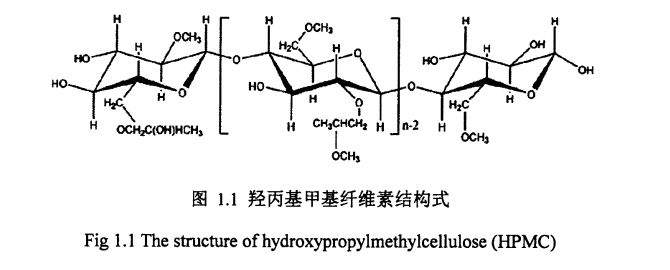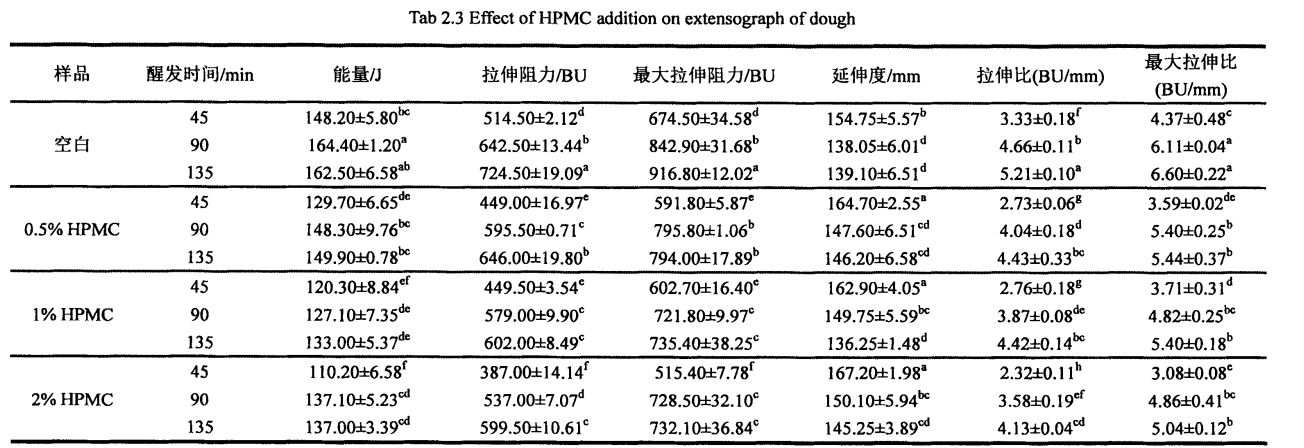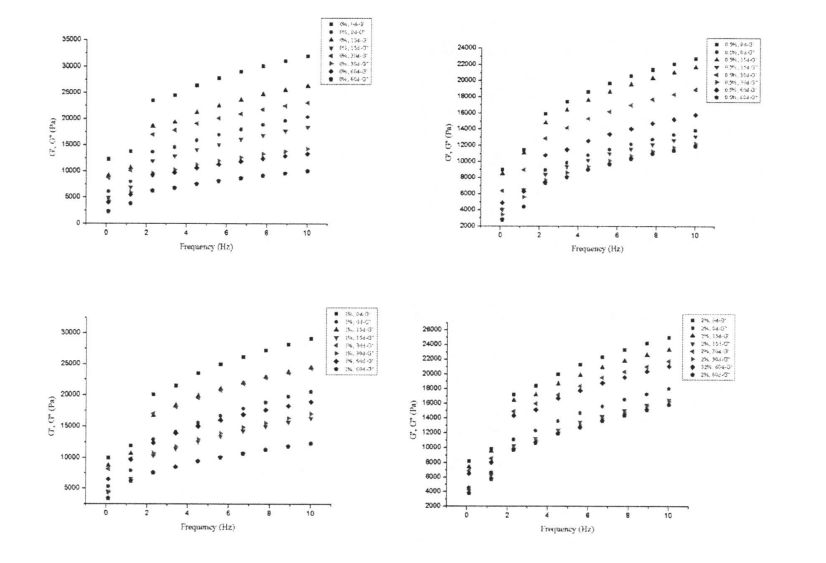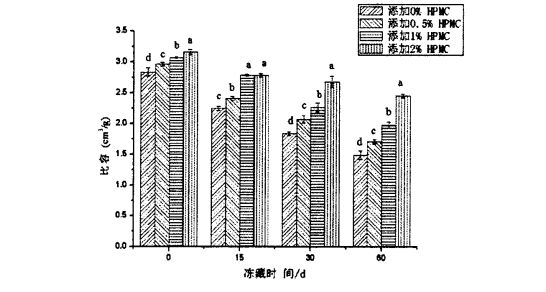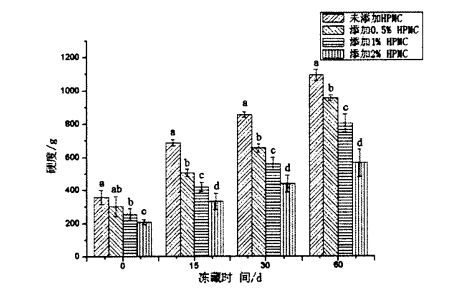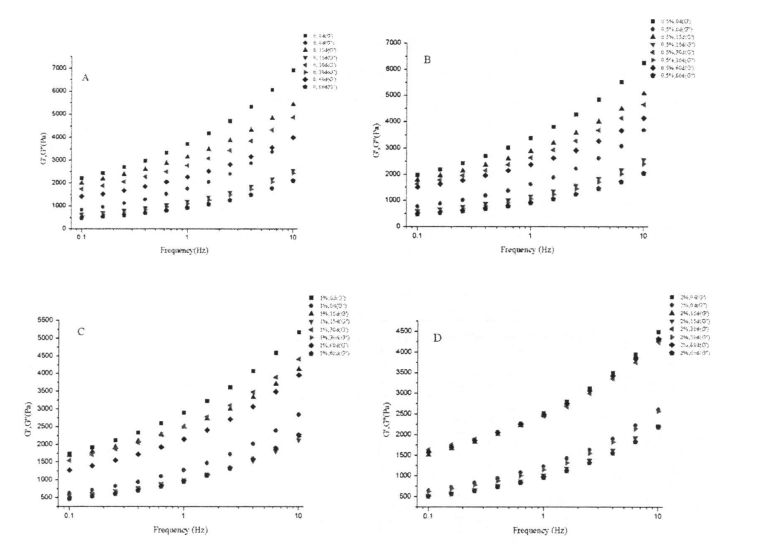The fermentation gas production activity of yeast has an important influence on the quality of fermented flour products. Atlikus eksperimentus, buvo nustatyta, kad, palyginti su kontroline grupe, HPMC pridėjimas galėtų geriau išlaikyti mielių fermentacijos aktyvumą ir sumažinti tarpląstelinio sumažėjusio glutationo kiekio padidėjimą po 60 dienų užšalimo, o tam tikrame diapazone HPMC apsauginis poveikis buvo teigiamai koreliuojamas su jo pridėjimo kiekiu.
Raktažodžiai: garuojama duona; užšaldyta tešla; hydroxypropyl methylcellulose; wheat gluten; wheat starch; yeast.
Turinio lentelė
1.1 Dabartinė tyrimų būklė namuose ir užsienyje ……………………………………………………… L
1.1.4 Šaldytos tešlos problemos ir iššūkiai ………………………………………………………… .3
1.1.6 Hidrokoloidų taikymas šaldytos tešlos kokybės pagerėjimui ………………… .5
1.1.7 Hydroxypropyl methyl cellulose (Hydroxypropyl methyl cellulose, I-IPMC) ………. 5
112 Tyrimo tikslas ir reikšmė ........................................................................ 6
2 SKYRIUS HPMC papildymo poveikis užšaldytos tešlos apdorojimo savybėms ir garuojamos duonos kokybei …………………………………………………………………………………………… ... 8
2.1 ĮVADAS .................................................................................................................................................................. 8
2.2.2 Eksperimentiniai instrumentai ir įranga ......................................................................... 8
2.3 Experimental results and discussion…………………………………………………………………… . 11
2.3.1 Pagrindinių kviečių miltų komponentų indeksas …………………………………………………………… .1L
2.3.2 HPMC pridėjimo poveikis farrinacinės tešlos savybėms ………………… .11
2.3.3 HPMC pridėjimo poveikis tempimo savybėms …………………………… 12
2.3.4 The effect of HPMC addition and freezing time on the rheological properties of dough…………………………. …………………………………………………………………………………………………………… .15
3 skyrius HPMC pridėjimo poveikis kviečių glitimo baltymų struktūrai ir savybėms užšalimo sąlygomis …………………………………………………………………………………………… ................... 24 24
3.2.4 Experimental methods ....................................................................................................... 25
3. Rezultatai ir diskusija ................................................................................................................... 29
3.3.2 HPMC kiekio ir užšalimo laikymo laiko pridėjimo poveikis šaldymo drėgmės kiekiui (CFW) ir šiluminis stabilumas …………………………………………………………………………. 30
3.3.3 Effects of HPMC addition amount and freezing storage time on free sulfhydryl content (C vessel) …………………………………………………………………………………………………………. . 34
3.3.6.
3.3.7.
4 skyrius HPMC papildymo poveikis krakmolo struktūrai ir savybėms užšaldytos laikymo sąlygomis ……………………………………………………………………………………………………………………………………………………………………………………………………………………………………………………………………………………………………………………………………………………………………………………………………………………………………………………………………………………………………………………………………………………………………………………………………………………………………… 44
4.1 ĮVADAS ............................................................................................................................................... 44
4.2 Experimental materials and methods ................................................................................. 45
4.2.1 Eksperimentinė medžiaga ............................................................................................................................ ………… .45
4.3 Analizė ir diskusija ........................................................................................................... 48
4.3.1 Kviečių krakmolo pagrindinių komponentų kiekis ………………………………………………………. 48
4.3.2 I-IPMC papildomo kiekio ir užšaldyto laikymo laiko poveikis kviečių krakmolo želatinizacijos charakteristikoms …………………………………………………………………………………………… .48
4.3.3 Effects of HPMC addition and freezing storage time on the shear viscosity of starch paste………………………………………………………………………………………………………………………………………. 52
4.3.4.
4.3.5 HPMC įtaka Papildomos sumos ir užšaldyto laikymo laikas krakmolo patinimui gebėjimui
4.3.6 Effects of I-IPMC addition amount and frozen storage time on the thermodynamic properties of starch ………………………………………………………………………………………………………. . 57
4.3.7.
4.4 Skyriaus santrauka .................................................................................................................. 6 1
Chapter 5 Effects of HPMC addition on yeast survival rate and fermentation activity under frozen storage conditions………………………………………………………………………………………………. . 62
5.1Introduction ............................................................................................................................. 62
5.2 Materials and methods ............................................................................................................ 62
5.2.2 Eksperimentiniai metodai. . . . . ……………………………………………………………………………. 63
5.3 Results and Discussion ............................................................................................................... 64
5.3.3 The effect of adding amount of HPMC and freezing time on the content of glutathione in dough……………………………………………………………………………………………………………66. "
5.4 Skyriaus santrauka ............................................................................................................... 67
6.1 IŠVADA ...................................................................................................................................................................................................................................................................................................................... 68
6.2 Outlook .......................................................................................................................................... 68
Figure 1.1 The structural formula of hydroxypropyl methylcellulose………………………. . 6
Figure 2.1 The effect of HPMC addition on the rheological properties of frozen dough…………………………………………………………………………………………………………………………………….. 15
2.2 pav. HPMC pridėjimo ir užšalimo laiko poveikis tam tikram garuojamos duonos tūriui ……………………………………………………………………………………………………………………………………………………………… ... 18
Figure 2.3 The effect of HPMC addition and freezing time on the hardness of steamed bread……………………………………………………………………………………………………………………………………... 19
Figure 2.4 The effect of HPMC addition and freezing time on the elasticity of steamed bread………………………………………………………………………………………………………………………………. . 20
Figure 3.1 The effect of HPMC addition and freezing time on the rheological properties of wet gluten…………………………………………………………………………………………………………………………. 30
Figure 3.2 Effects of HPMC addition and freezing time on the thermodynamic properties of wheat gluten………………………………………………………………………………………………………………. . 34
Figure 3.3 Effects of HPMC addition and freezing time on free sulfhydryl content of wheat gluten……………………………………………………………………………………………………………………………... . 35
3.6 pav. Iliustracija ........................................................................................................ ……… .39
3.7 pav. HPMC pridėjimo ir užšalimo laiko poveikis mikroskopiniam glitimo tinklo struktūrai ……………………………………………………………………………………………………………… .... 43
4.1 pav. Krakmolo želatinizacijos charakteristika kreivė ............................................................... 51
4.2 pav. Krakmolo pastos skysčių tiokotropija ................................................................................. .. 52
4.3 pav. 57
4.5 pav. HPMC pridėjimo ir užšalimo laikymo poveikis krakmolo termodinaminėms savybėms …………………………………………………………………………………………………………………………. . 59
5.1 pav. HPMC pridėjimo ir užšalimo laiko poveikis tešlos įrodymui …………………………………………………………………………………………………………………………………………………………………………………………………………… ... 66
5.2 pav. HPMC pridėjimo ir užšalimo laiko poveikis mielių išgyvenamumui …………………………………………………………………………………………………………………………………………………………… .... 67
Figure 5.3 Microscopic observation of yeast (microscopic examination) …………………………………………………………………………………………………………………………. 68
Figure 5.4 The effect of HPMC addition and freezing time on glutathione (GSH) content…………………………………………………………………………………………………………………………………... 68
2.1 lentelė. Pagrindinio kviečių miltų ingredientų kiekis ……………………………………………………. 11
2.3 lentelė. I-IPMC pridėjimo poveikis tešlos tempimo savybėms ………………………………… .14
2.5 lentelė. I-IPMC papildomo kiekio ir užšalimo laikymo efektas garuojamos duonos tekstūros savybėms ………………………………………………………………………………………………………… .21
3.1 lentelė. Pagrindinių glitimo ingredientų kiekis …………………………………………………………… .25
3.2 lentelė. I-IPMC papildomo kiekio ir užšalimo laikymo poveikis fazių perėjimo entalpijos (YI IV) ir šlapio glitimo vandens kiekiui (E pokalbiai) ………………………. 31
3.3 lentelė. 33
3.5 lentelė. HPMC pridėjimo ir užšalimo laiko poveikis antrinei kviečių glitimo struktūrai …………………………………………………………………………………………………………………………………………………………… .40
3.6 lentelė. I-IPMC pridėjimo ir užšalimo laikymo poveikis kviečių glitimo paviršiaus hidrofobiškumui …………………………………………………………………………………………………………. 41
4.2 lentelė. HPMC papildomo kiekio ir užšaldyto laikymo laiko poveikis kviečių krakmolo želatinizacijos charakteristikoms …………………………………………………………………………………………… 52
4.3 lentelė. I-IPMC pridėjimo ir užšalimo laiko poveikis kviečių krakmolo pastos šlyties klampumui ………………………………………………………………………………………………………………………………………………………………. 55
4.4 lentelė. I-IPMC papildomo kiekio ir užšaldyto laikymo laiko poveikis krakmolo želatinizacijos termodinaminėms savybėms ……………………………………………………………… .60
1.1Research Statusas namuose ir užsienyje
Steamed bread refers to the food made from the dough after proofing and steaming. As a traditional Chinese pasta food, steamed bread has a long history and is known as "Oriental Bread". Kadangi jo gatavas produktas yra pusrutulio arba pailgos formos, švelnaus skonio, skanaus skonio ir gausu maistinių medžiagų, jis ilgą laiką buvo plačiai populiarus tarp visuomenės. It is the staple food of our country, especially the northern residents. The consumption accounts for about 2/3 of the dietary structure of products in the north, and about 46% of the dietary structure of flour products in the country [21].
1)Development of new characteristic steamed buns. Vykdant garintos duonos žaliavų naujoves ir pridedant funkcines aktyvias medžiagas, buvo sukurtos naujos garintos duonos veislės, kurios turi ir mitybą, ir funkcijos. Established the evaluation standard for the quality of miscellaneous grain steamed bread by principal component analysis; Fu et a1. (2015) added lemon pomace containing dietary fiber and polyphenols to steamed bread, and evaluated the antioxidant activity of steamed bread; Hao & Beta (2012) studied barley bran and flaxseed (rich in bioactive substances) The production process of steamed bread [5]; Shiau et a1. (2015) evaluated the effect of adding pineapple pulp fiber on dough rheological properties and steamed bread quality [6].
2) Specialiųjų miltų perdirbimo ir sudėjimo duonos apdorojimo ir sudėjimo tyrimai. The effect of flour properties on the quality of dough and steamed buns and the research on new special flour for steamed buns, and based on this, an evaluation model of flour processing suitability was established [7]; Pavyzdžiui, skirtingų miltų frezavimo metodų poveikis miltų ir garintų bandelių kokybei [7] 81; The effect of the compounding of several waxy wheat flours on the quality of steamed bread [9J et al.; Zhu, Huang, &Khan (2001) evaluated the effect of wheat protein on the quality of dough and northern steamed bread, and considered that gliadin/ Glutenin was significantly negatively correlated with dough properties and steamed bread quality [lo]; Zhang, et a1. (2007) analyzed the correlation between gluten protein content, protein type, dough properties and steamed bread quality, and concluded that the content of high molecular weight glutenin subunit (1ligh.molecular-weight, HMW) and total protein content are all related to the quality of northern steamed bread. turi didelę įtaką [11].
3) Tešlos paruošimo ir garintos duonos gaminimo technologijos tyrimai. Research on the influence of steamed bread production process conditions on its quality and process optimization; Liu Changhong ir kt. (2009) showed that in the process of dough conditioning, process parameters such as water addition, dough mixing time, and dough pH value have an impact on the whiteness value of steamed bread. Tai daro didelę įtaką jutimo vertinimui. If the process conditions are not suitable, it will cause the product to turn blue, dark or yellow. The research results show that during the dough preparation process, the amount of water added reaches 45%, and the dough mixing time is 5 minutes, ~ When the pH value of the dough was 6.5 for 10 min, the whiteness value and sensory evaluation of the steamed buns measured by the whiteness meter were the best. Tešlą valcuodama 15-20 kartų tuo pačiu metu, tešla yra plokščia, lygi, elastinga ir blizganti paviršius; Kai valcavimo santykis yra 3: 1, tešlos lapas yra blizgus, o garuojamos duonos baltumas padidėja [l iki; Li, et A1. (2015) ištyrė sudėtinės fermentuotos tešlos gamybos procesą ir jos pritaikymą garuojamai duonos apdorojimui [13].
4)Research on quality improvement of steamed bread. Research on the addition and application of steamed bread quality improvers; Daugiausia įtraukiant priedus (tokius kaip fermentai, emulsikliai, antioksidantai ir kt.) Ir kitus egzogeninius baltymus [14], krakmolą ir modifikuotą krakmolą [15] ir kt. of patients with Coeliac Disease [16.1 cit.
5)Preservation and anti-aging of steamed bread and related mechanisms. Pan Lijun ir kt. (2010) optimizavo kompozicinį modifikatorių, turintį gerą anti-senėjimo efektą per eksperimentinį dizainą [l ne; Wang, et A1. (2015) studied the effects of gluten protein polymerization degree, moisture, and starch recrystallization on the increase of steamed bread hardness by analyzing the physical and chemical properties of steamed bread. Rezultatai parodė, kad vandens praradimas ir krakmolo perkristalizacija buvo pagrindinės garuojamos duonos senėjimo priežastys [20].
6)Research on the application of new fermented bacteria and sourdough. Jiang, et A1. (2010) Chaetomio sp. fermented to produce xylanase (with thermostable) in steamed bread [2l'; Gerez, et a1. (2012) used two kinds of lactic acid bacteria in fermented flour products and evaluated their quality [221; Wu, et al. (2012) studied the influence of sourdough fermented by four kinds of lactic acid bacteria (Lactobacillus plantarum, Lactobacillus, sanfranciscemis , Lactobacillus brevis and Lactobacillus delbrueckii subsp bulgaricus) on the quality (specific volume, texture, fermentation flavor, etc.) of northern steamed bread [23]; and Gerez, et a1. (2012) used the fermentation characteristics of two kinds of lactic acid bacteria to accelerate the hydrolysis of gliadin to reduce the allergenicity of flour products [24] and other aspects.
Among them, steamed bread is prone to aging under conventional storage conditions, which is an important factor restricting the development of steamed bread production and processing industrialization. After aging, the quality of steamed bread is reduced - the texture becomes dry and hard, dregs, shrinks and cracks, the sensory quality and flavor deteriorate, the digestion and absorption rate decreases, and the nutritional value decreases. Tai ne tik daro įtaką jos galiojimo laikui, bet ir sukuria daug atliekų. Remiantis statistika, metiniai nuostoliai dėl senėjimo yra 3% miltų produktų produkcijos. 7%. With the improvement of people's living standards and health awareness, as well as the rapid development of the food industry, how to industrialize the traditional popular staple noodle products including steamed bread, and obtain products with high quality, long shelf life and easy preservation to meet the needs of the growing demand for fresh, safe, high-quality and convenient food is a long-standing technical problem. Based on this background, frozen dough came into being, and its development is still in the ascendant.
1.1.3 Įvedimas į šaldytą tešlą
Frozen dough is a new technology for the processing and production of flour products developed in the 1950s. Tai daugiausia nurodo kviečių miltų naudojimą kaip pagrindinę žaliavą ir vandenį ar cukrų kaip pagrindines pagalbines medžiagas. Baked, packed or unpacked, quick-freezing and other processes make the product reach a frozen state, and in. For products frozen at 18"C, the final product needs to be thawed, proofed, cooked, etc. [251].
a) Šaldytos tešlos metodas: tešla yra padalinta į vieną gabalą, greitai užšaldytą, užšaldytą, atšildytą, įrodytą ir virtą (kepimas, garuoja ir kt.)
b) Išankstinis atsparumas ir užšalimo tešlos metodas: Tešla padalinta į vieną dalį, viena dalis yra įrodyta, viena-greitai užšaldyta, viena-užšaldyta, viena yra atšildyta, vienas yra įrodytas, o vienas-virtas (kepimas, garuoja ir kt.)
Cakes and other pasta products have different degrees of application [26-27]. According to incomplete statistics, by 1990, 80% of bakeries in the United States used frozen dough; 50% kepyklų Japonijoje taip pat naudojo šaldytą tešlą. twentieth century
Dešimtajame dešimtmetyje į Kiniją buvo įvesta šaldytos tešlos apdorojimo technologija. Nuolat plėtojant mokslą ir technologijas bei nuolat tobulinant žmonių gyvenimo standartus, „Frozen Tough Technology“ turi plačias plėtros perspektyvas ir didžiulę plėtros erdvę
Daugelyje tyrimų nustatyta, kad ledo kristalų susidarymas ir augimas šaldytame maisto produktuose yra svarbus veiksnys, lemiantis produkto kokybės pablogėjimą [291]. Ledo kristalai ne tik sumažina mielių išgyvenamumą, bet ir susilpnina glitimo stiprumą, daro įtaką krakmolo kristališkumui ir gelio struktūrai, pažeidžia mielių ląsteles ir išskiria redukuojančią glutationą, o tai dar labiau sumažina glitimo dujų sulaikymo pajėgumą. Be to, šaldyto laikymo atveju temperatūros svyravimai gali sukelti ledo kristalų augimą dėl perkristalizacijos [30]. Todėl, kaip kontroliuoti neigiamą ledo kristalų susidarymo ir augimo poveikį krakmolui, glitimui ir mieliams, yra raktas sprendžiant aukščiau nurodytas problemas, tai taip pat yra karšta tyrimų sritis ir kryptis. In the past ten years, many researchers have been engaged in this work and achieved some fruitful research results. However, there are still some gaps and some unresolved and controversial issues in this field, which need to be further explored, such as:
a)How to restrain the quality deterioration of frozen dough with the extension of frozen storage time, especially how to control the influence of the formation and growth of ice crystals on the structure and properties of the three main components of dough (starch, gluten and yeast), is still an issue. Šios tyrimų srities taškai ir pagrindiniai klausimai;
b) Kadangi yra tam tikrų skirtumų, susijusių su skirtingų miltų gaminių apdorojimo ir gamybos technologijomis bei formule, vis dar trūksta tyrimų dėl atitinkamos specialios šaldytos tešlos sukūrimo kartu su skirtingais produktų tipais;
c)Expand, optimize and use new frozen dough quality improvers, which is conducive to the optimization of production enterprises and the innovation and cost control of product types. Šiuo metu tai dar reikia dar labiau sustiprinti ir išplėsti;
1,1.5RESORDA
Atsižvelgiant į aukščiau pateiktas užšaldytos tešlos problemas ir iššūkius, ilgalaikiai novatoriški tyrimai, susiję su šaldytos tešlos technologijos taikymo, kokybės kontrolės ir pagerinimo užšaldytų tešlos produktų tobulinimu, ir su tuo susijusius pokyčius, susijusius su medžiagų komponentų struktūros ir savybių pokyčių mechanizmu, pastaraisiais metais užšaldytos tešlos sistemoje. Specifically, the main domestic and foreign researches in recent years mainly focus on the following points:
i.Study the changes in the structure and properties of frozen dough with the extension of freezing storage time, in order to explore the reasons for the deterioration of product quality, especially the effect of ice crystallization on biological macromolecules (protein, starch, etc.), for example, ice crystallization. Formation and growth and its relationship with water state and distribution; kviečių glitimo baltymų struktūros, konformacijos ir savybių pokyčiai [31]; krakmolo struktūros ir savybių pokyčiai; Tešlos mikrostruktūros ir susijusių savybių pokyčiai ir kt. 361.
Ii. Optimization of frozen dough production process, frozen storage conditions and formula. During the production of frozen dough, temperature control, proofing conditions, pre-freezing treatment, freezing rate, freezing conditions, moisture content, gluten protein content, and thawing methods will all affect the processing properties of frozen dough [37]. In general, higher freezing rates produce ice crystals that are smaller in size and more uniformly distributed, while lower freezing rates produce larger ice crystals that are not uniformly distributed. In addition, a lower freezing temperature even below the glass transition temperature (CTA) can effectively maintain its quality, but the cost is higher, and the actual production and cold chain transportation temperatures are usually small. Be to, užšalimo temperatūros svyravimas sukels perkristalizaciją, o tai paveiks tešlos kokybę.
Iii. Using additives to improve the product quality of frozen dough. In order to improve the product quality of frozen dough, many researchers have made explorations from different perspectives, for example, improving the low temperature tolerance of material components in frozen dough, using additives to maintain the stability of the dough network structure [45.56], etc. Among them, the use of additives is an effective and widely used method. Mainly include, i) enzyme preparations, such as, transglutaminase, O [. Amylase; ii) emulsifiers, such as monoglyceride stearate, DATEM, SSL, CSL, DATEM, etc.; iii) antioxidants, ascorbic acid, etc.; iv) polysaccharide hydrocolloids, such as guar gum, yellow Originalgum, gum Arabic, konjac gum, sodium alginate, etc.; v) other functional substances, such as Xu, et a1. (2009) added Ice-structuring Proteins to wet gluten mass under freezing conditions, and studied its protective effect and mechanism on the structure and function of gluten protein [y71.
Ⅳ. Breeding of antifreeze yeast and application of new yeast antifreeze [58-59]. Sasano, et a1. (2013) gavo įšalę tolerantiškų mielių padermių per hibridizaciją ir rekombinaciją tarp skirtingų padermių [60–61], o S11i, Yu ir Lee (2013) ištyrė biogeninį ledo branduolį, gautą iš Erwinia Herbicans, naudojamų fermentacijos gyvybingumui užšalimo sąlygomis [62J.
1.1.6 HINROCOLLOIDŲ APPLIKIMAS Šaldytos tešlos kokybės pagerėjimas
Cheminis hidrokolloido pobūdis yra polisacharidas, kurį sudaro monosacharidai (gliukozė, rhamnozė, arabinozė, mannozė ir kt.) Per 0 [. 1-4. Glycosidic bond or/and a. 1-"6. Glikozidinis ryšys arba B. 1-4. Glikozidinis ryšys ir 0 [.1-3. Aukštas molekulinis organinis junginys, suformuotas kondensuojant glikozidinį ryšį, turi turtingą veislę ir gali būti apytiksliai padalytas į: ① celiuliozės darinius, tokius kaip tokios metil-celiuliozės (MC), karboksimetil-celiuliozės (cmc); GUM, GUAR GUM, gumos arabų kalba; Todėl hidrofilinių koloidų pridėjimas suteikia daugybę funkcijų, savybių ir hidrokolloidų savybių yra glaudžiai susijusios su polisacharidų ir vandens bei kitų makromolekulinių medžiagų sąveika. Wang Xin ir kt. (2007) ištyrė jūros dumblių polisacharidų ir želatinos pridėjimo poveikį tešlos perėjimo temperatūrai [631. Wang Yusheng ir kt. (2013) manė, kad sudėtinis įvairių hidrofilinių koloidų pridėjimas gali žymiai pakeisti tešlos srautą. Pakeiskite savybes, pagerinkite tempimo stiprumą tešlą, padidinkite tešlos elastingumą, tačiau sumažinkite tešlos išplėtimą [ištrinti.
Hidroksipropilo metil -celiuliozė (hidroksipropilo metil -celiuliozė, HPMC) yra natūraliai atsirandantis celiuliozės darinys, susidarantis hidroksipropilo ir metilo, iš dalies pakeičiantis hidroksilą ant celiuliozės šoninės grandinės [65] (1 pav. 1). The United States Pharmacopeia (United States Pharmacopeia) divides HPMC into three categories according to the difference in the degree of chemical substitution on the side chain of HPMC and the degree of molecular polymerization: E (Hypromellose 2910), F (Hypromellose 2906) and K (Hypromellose 2208).
Dėl vandenilio jungčių tiesinėje molekulinėje grandinėje ir kristalinės struktūroje egzistuojant, celiuliozė turi prastą vandens tirpumą, kuris taip pat riboja jo taikymo diapazoną. Tačiau pakaitalų buvimas HPMC šoninėje grandinėje nutraukia intramolekulinius vandenilio ryšius, todėl jis tampa hidrofilinėmis [66L], kuris gali greitai išsipūsti vandenyje ir sudaryti stabilią storą koloidinę dispersiją esant žemai temperatūrai. HPMC, kaip celiuliozės išvestinių hidrofilinių koloidų, buvo plačiai naudojamas medžiagų, popieriaus gamybos, tekstilės, kosmetikos, vaistų ir maisto srityse [6 71]. In particular, due to its unique reversible thermo-gelling properties, HPMC is often used as a capsule component for controlled release drugs; Maisto metu HPMC taip pat naudojamas kaip paviršiaus aktyviosios medžiagos, tirštikliai, emulsikliai, stabilizatoriai ir kt., Ir vaidina svarbų vaidmenį gerinant susijusių produktų kokybę ir realizuojant specifines funkcijas. Pavyzdžiui, pridėjus HPMC, gali pakeisti krakmolo želatinizacijos charakteristikas ir sumažinti krakmolo pastos gelio stiprumą. , HPMC gali sumažinti drėgmės praradimą maiste, sumažinti duonos šerdies kietumą ir efektyviai slopinti duonos senėjimą.
Nors HPMC tam tikru mastu buvo naudojamas makaronuose, jis daugiausia naudojamas kaip anti-senėjimo agentas ir vandens sulaikymo agentas duonai ir kt., Tai gali pagerinti specifinį produkto tūrį, tekstūros savybes ir prailginti galiojimo laiką [71.74]. Tačiau, palyginti su hidrofiliniais koloidais, tokiais kaip guar guma, ksantano guma ir natrio alginatas [75-771], nėra daug tyrimų apie HPMC naudojimą šaldytoje tešte, nesvarbu, ar tai gali pagerinti garintos duonos, apdorotos iš šaldytos tešlos, kokybę. There is still a lack of relevant reports on its effect.
1.2Research TIKSLAS IR REIKIMAS
At present, the application and large-scale production of frozen dough processing technology in my country as a whole is still in the development stage. Tuo pačiu metu yra tam tikrų spąstų ir trūkumų pačioje šaldytoje tešloje. Šie išsamūs veiksniai neabejotinai riboja tolesnį šaldytos tešlos taikymą ir skatinimą. Kita vertus, tai taip pat reiškia, kad užšaldytos tešlos taikymas turi didelę potencialą ir plačias perspektyvas, ypač iš šriftos tešlos technologijos derinimo požiūriu į pramoninę tradicinių kinų makaronų (ne) fermentuoto kuokštelinio maisto gamybą, kad būtų sukurta daugiau produktų, tenkinančių Kinijos gyventojų poreikius. Tai yra praktinė reikšmė pagerinti užšaldytos tešlos kokybę, remiantis kinų tešlos ir mitybos įpročių savybėmis, ir tai tinka Kinijos konditerijos apdorojimo ypatybėms.
1.3 Pagrindinis tyrimo turinys
Papildomo kiekio ir užšaldyto laikymo laiko poveikis užšaldytos tešlos struktūrai ir savybėms, užšaldytų tešlos produktų (garuojamos duonos) kokybė, kviečių glitimo struktūra ir savybės, kviečių krakmolo struktūra ir savybės bei mielių fermentacijos aktyvumas. Based on the above considerations, the following experimental design was made in this research topic:
1)Select a new type of hydrophilic colloid, hydroxypropyl methylcellulose (HPMC) as an additive, and study the addition amount of HPMC under different freezing time (0, 15, 30, 60 days; the same below) conditions. (0%, 0,5%, 1%, 2%; tas pats žemiau) Dėl šaldytos tešlos reologinių savybių ir mikrostruktūros, taip pat ant tešlos produkto - garintos duonos kokybės (įskaitant specifinę garintos duonos tūrį), ištirti garintos duonos kokybę ir įvertinti HPMC padidėjimą HPMC prie HPMC. processing properties of the frozen dough;
3) Žvelgiant iš tobulinimo mechanizmo perspektyvos, buvo tiriamos skirtingų HPMC papildymų poveikis želatinizacijos savybėms, gelio savybėms, kristalizacijos savybėms ir termodinaminėms krakmolo savybėms esant skirtingoms užšalimo laikymo laiko sąlygoms.
2.1 Įvadas
Paprastai tariant, medžiaga tešlos sudėtis, naudojama fermentuotų miltų gaminiams gaminti, daugiausia apima biologines makromolekulines medžiagas (krakmolą, baltymus), neorganinį vandenį ir organizmų mieles, ir susidaro po hidratacijos, kryžminio sujungimo ir sąveikos. Sukurta stabili ir sudėtinga medžiagų sistema su specialia struktūra. Numerous studies have shown that the properties of the dough have a significant impact on the quality of the final product. Therefore, by optimizing the compounding to meet the specific product and it is a research direction to improve the dough formulation and technology of the quality of the product or food for use; on the other hand, improving or improving the properties of dough processing and preservation to ensure or improve the quality of the product is also an important research issue.
Kaip minėta įvade, pridedant HPMC prie tešlos sistemos ir ištyrę jos poveikį tešlos savybėms (Farinas, pailgėjimas, reologija ir kt.) Ir galutinės produkto kokybė yra du glaudžiai susiję tyrimai.
Todėl šis eksperimentinis dizainas daugiausia atliekamas iš dviejų aspektų: HPMC papildymo poveikis užšaldytos tešlos sistemos savybėms ir poveikis garintų duonos gaminių kokybei.
2.2 Eksperimentinės medžiagos ir metodai
Zhongyu Wheat Flour Binzhou Zhongyu Food Co., Ltd.; Angel Active Dry Yeast Angel Yeast Co., Ltd.; HPMC (metilo pakeitimo laipsnis 28%.30%, hidroksipropilo pakeitimo laipsnis 7%.12%) Aladdin (Šanchajus) cheminio reagento įmonė; all chemical reagents used in this experiment are of analytical grade;
2.2.2 Eksperimentiniai instrumentai ir įranga
Instrumentas ir įrangos pavadinimas
BPS. 500CL constant temperature and humidity box
Sm. 986S dough mixer
C21. KT2134 indukcinė viryklė
Powder meter. E
Extensometer. E
Fd. 1b. 50 Vacuum Freeze Dryer
SX2.4.10 Mufelių krosnis
Gamintojas
Pekinas Bo Yi Kang Experimental Instrument Co., Ltd.
„Huang Shi Heng Feng Medical Equipment Co., Ltd.“
2.2.3 Eksperimentinis metodas
Remiantis GB 50093.2010, GB 5009.5–2010, GB/T 5009.9.2008, GB50094.2010T78-81], nustatykite pagrindinius kviečių miltų komponentus-drėgmės, baltymų, krakmolo ir pelenų kiekį.
Remiantis etaloniniu metodu, GB/T 14614.2006 NUSTATYMAS Tešlos savybių nustatymas [821.
2.2.3.3
Žr. GB/T 17320.1998 tešlos gamybos procesą [84]. Sverkite 450 g miltų ir 5 g aktyvių sausų mielių į tešlos maišytuvo dubenį, išmaišykite mažu greičiu, kad pilnai sumaišytumėte abu, o po to įpilkite 245 ml žemos temperatūros (distiliuotas vanduo (iš anksto laikomas šaldytuve 4 ° C temperatūroje 4 minutes, kad būtų suformuotas mielių aktyvumas), pirmiausia sujunkite maždaug 18 min. portion, knead it into a cylindrical shape, then seal it with a ziplock bag, and put it in. Freeze at 18°C for 15, 30, and 60 days. Add 0.5%, 1%, 2% (w/w, dry basis) HPMC to replace the corresponding proportion of flour quality to make dough, and the rest of the production methods remain unchanged. The 0-day frozen storage (unfrozen storage) was used as the control experimental group.
2.2.3.5 Tešlos reologinių savybių nustatymas
Išimkite tešlos pavyzdžius po atitinkamo užšalimo laiko, sudėkite juos į šaldytuvą 4 ° C temperatūroje 4 valandas, tada padėkite juos į kambario temperatūrą, kol tešlos mėginiai bus visiškai ištirpę. Mėginių apdorojimo metodas taip pat taikomas eksperimentinei 2.3.6 daliai.
Iš dalies išlydytos tešlos centrinės dalies centrinės dalies mėginys (apie 2 g) buvo supjaustytas ir dedamas ant apatinės reometro plokštelės („Discovery R3“). First, the sample was subjected to dynamic strain scanning. The specific experimental parameters were set as follows: A parallel plate with a diameter of 40 mm was used, the gap was set to 1000 mln, the temperature was 25 °C, and the scanning range was 0.01%. 100%, mėginio poilsio laikas yra 10 min., O dažnis nustatomas kaip 1Hz. Ištirtų mėginių tiesinė viskoelastingumo sritis (LVR) buvo nustatyta deformacijos skenavimu. Then, the sample was subjected to a dynamic frequency sweep, and the specific parameters were set as follows: the strain value was 0.5% (in the LVR range), the resting time, the fixture used, the spacing, and the temperature were all consistent with the strain sweep parameter settings. Five data points (plots) were recorded in the rheology curve for each 10-fold increase in frequency (linear mode). After each clamp depression, the excess sample was gently scraped with a blade, and a layer of paraffin oil was applied to the edge of the sample to prevent water loss during the experiment. Kiekvienas mėginys buvo pakartotas tris kartus.
2.2.3.6 Šaldančio vandens kiekis (šaldyto vandens kiekis, CF vidinis nustatymas) tešloje
Sverikite maždaug 15 mg visiškai ištirpintos tešlos centrinės dalies mėginį, užkandykite ją aliuminio tiglyje (tinkamas skystiems mėginiams) ir išmatuokite diferencine skenavimo kalorimetrija (DSC). Nustatyti konkretūs programos parametrai. Taip: pirmiausia pusiausvyros 20 ° C temperatūroje 5 minutes, tada nukrituokite iki 0,30 ° C greičiu 10 colių/min., Laikykite 10 min., Ir pagaliau pakilkite iki 25 ° C greičiu 5 colių c/min, valymo dujos yra azoto (N2), o jo srautas buvo 50 ml/min. Using the blank aluminum crucible as a reference, the obtained DSC curve was analyzed using the analysis software Universal Analysis 2000, and the melting enthalpy (day) of the ice crystal was obtained by integrating the peak located at about 0°C. Freezable water content (CFW) is calculated by the following formula [85.86]:
Among them, 厶 represents the latent heat of moisture, and its value is 334 J Dan; MC (bendras drėgmės kiekis) parodo bendrą tešlos drėgmės kiekį (matuojamas pagal GB 50093.2010T78]). Each sample was repeated three times.
2.2.3.7 Garintos duonos gamyba
After the corresponding freezing time, the frozen dough was taken out, first equilibrated in a 4°C refrigerator for 4 h, and then placed at room temperature until the frozen dough was completely thawed. Divide the dough into about 70 grams per portion, knead it into shape, and then put it into a constant temperature and humidity box, and proof it for 60 minutes at 30°C and a relative humidity of 85%. Po įrodymo, garuokite 20 minučių, o po to 1 valandą atvėsinkite kambario temperatūroje, kad įvertintumėte garintos duonos kokybę.
Garinta duonos tūris (cm3 / g) = garuojamos duonos tūris (CM3) / garuojama duonos masė (G)
Refer to the method of Sim, Noor Aziah, Cheng (2011) [88] with minor modifications. Iš virto duonos centrinės duonos centrinės srities buvo išpjaustytas 20x 20 x 20 MN'13 šerdies pavyzdys, o garintos duonos TPA (tekstūros profilio analizė) buvo matuojamas fizinės nuosavybės testeriu. Specifiniai parametrai: zondas yra P/100, prieš pradedamąjį nustatymą greitis yra 1 mm/s, vidurio matavimo greitis yra 1 mm/s, pomirtinio nustatymo greitis yra 1 mm/s, suspaudimo deformacijos kintamasis yra 50%, o laiko intervalas tarp dviejų suspaudimų yra 30 s, trigerio jėga yra 5 g. Each sample was repeated 6 times.
All experiments were repeated at least three times unless otherwise specified, and the experimental results were expressed as the mean (Mean) ± standard deviation (Standard Deviation). SPSS Statistic 19 was used for analysis of variance (Analysis of Variance, ANOVA), and the significance level was O. 05; Norėdami nubrėžti atitinkamas diagramas, naudokite „Origin 8.0“.
2.3 Eksperimentiniai rezultatai ir diskusija
2.3.2 I-IPMC papildymo poveikis farrinacinėms tešlos savybėms
As shown in Table 2.2, with the increase of HPMC addition, the water absorption of dough increased significantly, from 58.10% (without adding HPMC dough) to 60.60% (adding 2% HPMC dough). Be to, pridėjus HPMC, tešlos stabilumo laikas pagerino nuo 10,2 min. (Blank) iki 12,2 min. (Pridėta 2% HPMC). However, with the increase of HPMC addition, both the dough forming time and the dough weakening degree decreased significantly, from the blank dough forming time of 2.10 min and the weakening degree of 55.0 FU, respectively, to the addition of 2% HPMC, the dough forming time was 1. .50 min and weakening degree of 18.0 FU, decreased by 28.57% and 67.27%, respectively.
The tensile properties of the dough can better reflect the processing properties of the dough after proofing, including the extensibility, tensile resistance and stretch ratio of the dough. The tensile properties of the dough are attributed to the extension of the glutenin molecules in the dough extensibility, as the cross-linking of glutenin molecular chains determines the elasticity of the dough [921]. Termonia, Smith (1987) [93] manė, kad polimerų pailgėjimas priklauso nuo dviejų cheminių kinetinių procesų, tai yra, antrinių ryšių tarp molekulinių grandinių ir kryžminių sujungtų molekulinių grandinių deformacijos. When the deformation rate of the molecular chain is relatively low, the molecular chain cannot sufficiently and quickly cope with the stress generated by the stretching of the molecular chain, which in turn leads to the breakage of the molecular chain, and the extension length of the molecular chain is also short. Only when the deformation rate of the molecular chain can ensure that the molecular chain can be deformed quickly and sufficiently, and the covalent bond nodes in the molecular chain will not be broken, the elongation of the polymer can be increased. Therefore, changing the deformation and elongation behavior of the gluten protein chain will have an impact on the tensile properties of the dough [92].
2.3 lentelėje pateiktas skirtingų HPMC (O, 0,5%, 1%ir 2%) kiekių ir skirtingų įrodymų 1'9 (45 min. The experimental results show that the tensile properties of all dough samples increase with the extension of the proofing time except the elongation which decreases with the extension of the proofing time. For the energy value, from 0 to 90 min, the energy value of the rest of the dough samples increased gradually except for the addition of 1% HPMC, and the energy value of all dough samples increased gradually. There were no significant changes. This shows that when the proofing time is 90 min, the network structure of the dough (cross-linking between molecular chains) is completely formed. Therefore, the proofing time is further extended, and there is no significant difference in the energy value. At the same time, this can also provide a reference for determining the proofing time of the dough. As the proofing time prolongs, more secondary bonds between molecular chains are formed and the molecular chains are more closely cross-linked, so the tensile resistance and the maximum tensile resistance increase gradually. At the same time, the deformation rate of molecular chains also decreased with the increase of secondary bonds between molecular chains and the tighter cross-linking of molecular chains, which led to the decrease of the elongation of the dough with the excessive extension of the proofing time. The increase in tensile resistance/maximum tensile resistance and the decrease in elongation resulted in an increase in tensile LL/maximum tensile ratio.
2.3.4.
Tešlos reologinės savybės yra svarbus tešlos savybių aspektas, kuris gali sistemingai atspindėti išsamias tešlos savybes, tokias kaip viskoelastingumas, stabilumas ir apdorojimo charakteristikos, taip pat apie savybių pokyčius perdirbimo ir laikymo metu.
2.1 pav. HPMC pridėjimo poveikis šaldytos tešlos reologinėms savybėms
2.1 paveiksle parodytas laikymo modulio (elastinio modulio, G ') ir nuostolių modulio (klampus modulis, G ") tešlos, turinčios skirtingą HPMC kiekį nuo 0 dienų iki 60 dienų, pasikeitė. Rezultatai parodė, kad prailginant užšalimo laikymą, tešlos g' /g ' /G' /G ' /G' /G ' /G' /G ' /G' /G ' /G' /G ' /Gehing žymiai sumažėjo, o G' /G 'G' (g 'G' (g 'g'“ (G 'G' (G '(G' (G ') (G' g ' /G' /G ' /G' /G ' /G' /G ' /G., kai jis smarkiai sumažėjo, o padidėjus G' /G 'G' (G 'G' (G 'g'). Taip gali būti dėl to, kad tešlos tinklo struktūrą sugadina ledo kristalai užšalimo laikymo metu, o tai sumažina jo struktūrinį stiprumą, taigi elastinis modulis žymiai mažėja. However, with the increase of HPMC addition, the variation of G' gradually decreased. In particular, when the added amount of HPMC was 2%, the variation of G' was the smallest. This shows that HPMC can effectively inhibit the formation of ice crystals and the increase in the size of ice crystals, thereby reducing the damage to the dough structure and maintaining the structural strength of the dough. In addition, the G' value of dough is greater than that of wet gluten dough, while the G" value of dough is smaller than that of wet gluten dough, mainly because the dough contains a large amount of starch, which can be adsorbed and dispersed on the gluten network structure. It increases its strength while retaining excess moisture.
Not all the moisture in the dough can form ice crystals at a certain low temperature, which is related to the state of the moisture (free-flowing, restricted, combined with other substances, etc.) and its environment. Šaldus vanduo yra tešlos vanduo, kuris gali pakeisti fazę, kad susidarytų ledo kristalai žemoje temperatūroje. Šaldinamo vandens kiekis tiesiogiai veikia ledo kristalų susidarymo skaičių, dydį ir pasiskirstymą. In addition, the freezable water content is also affected by environmental changes, such as the extension of freezing storage time, the fluctuation of freezing storage temperature, and the change of material system structure and properties. For the frozen dough without added HPMC, with the prolongation of freezing storage time, Q silicon increased significantly, from 32.48±0.32% (frozen storage for 0 days) to 39.13±0.64% (frozen storage for 0 days). Tibetan for 60 days), the increase rate was 20.47%. However, after 60 days of frozen storage, with the increase of HPMC addition, the increase rate of CFW decreased, followed by 18.41%, 13.71%, and 12.48% (Table 2.4). At the same time, the o∥ of the unfrozen dough decreased correspondingly with the increase of the amount of HPMC added, from 32.48a-0.32% (without adding HPMC) to 31.73±0.20% in turn. (adding0.5% HPMC), 3 1.29+0.03% (adding 1% HPMC) and 30.44±0.03% (adding 2% HPMC) Water holding capacity, inhibits the free flow of water and reduces the amount of water that can be frozen. In the process of freezing storage, along with recrystallization, the dough structure is destroyed, so that part of the non-freezable water is converted into freezable water, thus increasing the content of freezable water. However, HPMC can effectively inhibit the formation and growth of ice crystals and protect the stability of the dough structure, thus effectively inhibiting the increase of the freezable water content. This is consistent with the change law of the freezable water content in the frozen wet gluten dough, but because the dough contains more starch, the CFW value is smaller than the G∥ value determined by the wet gluten dough (Table 3.2).
2.3.6.1.
The specific volume of steamed bread can better reflect the appearance and sensory quality of steamed bread. The larger the specific volume of the steamed bread, the larger the volume of the steamed bread of the same quality, and the specific volume has a certain influence on the appearance, color, texture, and sensory evaluation of the food. Paprastai tariant, garintos bandelės, turinčios didesnį specifinį tūrį, tam tikru mastu taip pat yra populiaresni tarp vartotojų.
The specific volume of steamed bread can better reflect the appearance and sensory quality of steamed bread. The larger the specific volume of the steamed bread, the larger the volume of the steamed bread of the same quality, and the specific volume has a certain influence on the appearance, color, texture, and sensory evaluation of the food. Paprastai tariant, garintos bandelės, turinčios didesnį specifinį tūrį, tam tikru mastu taip pat yra populiaresni tarp vartotojų.
However, the specific volume of the steamed bread made from frozen dough decreased with the extension of the frozen storage time. Among them, the specific volume of the steamed bread made from the frozen dough without adding HPMC was 2.835±0.064 cm3/g (frozen storage). 0 days) down to 1.495±0.070 cm3/g (frozen storage for 60 days); while the specific volume of steamed bread made from frozen dough added with 2% HPMC dropped from 3.160±0.041 cm3/g to 2.160±0.041 cm3/g. 451±0.033 cm3/g, therefore, the specific volume of the steamed bread made from the frozen dough added with HPMC decreased with the increase of the added amount. Since the specific volume of steamed bread is not only affected by the yeast fermentation activity (fermentation gas production), the moderate gas holding capacity of the dough network structure also has an important impact on the specific volume of the final product [96'9 cited. The measurement results of the above rheological properties show that the integrity and structural strength of the dough network structure are destroyed during the freezing storage process, and the degree of damage is intensified with the extension of the freezing storage time. Proceso metu jo dujų sulaikymo pajėgumas yra prastas, o tai savo ruožtu sumažina tam tikrą garintos duonos tūrį. However, the addition of HPMC can more effectively protect the integrity of the dough network structure, so that the air-holding properties of the dough are better maintained, therefore, in O. During the 60-day frozen storage period, with the increase of HPMC addition, the specific volume of the corresponding steamed bread decreased gradually.
2.3.6.2.
TPA (tekstūros profilio analizė) Fizinės savybės testas gali išsamiai atspindėti makaronų maisto mechanines savybes ir kokybę, įskaitant kietumą, elastingumą, sanglaudą, kramtomumą ir atsparumą. Figure 2.3 shows the effect of HPMC addition and freezing time on the hardness of steamed bread. Rezultatai rodo, kad šviežios tešlos metu be užšalimo gydymo, padidėjus HPMC, garuojamos duonos kietumas žymiai padidėja. decreased from 355.55±24.65g (blank sample) to 310.48±20.09 g (add O.5% HPMC), 258.06±20.99 g (add 1% t-IPMC) and 215.29 + 13.37 g (2% HPMC added). Tai gali būti susiję su specifinio garintos duonos tūrio padidėjimu. Be to, kaip matyti iš 2.4 pav., Padidėjus HPMC kiekiui, padidėja garuojamos duonos, pagamintos iš šviežios tešlos, spyruoklė žymiai padidėja - atitinkamai nuo 0,968 ± 0,006 (tuščia) iki 1. .020 ± 0,004 (pridėkite 0,5% HPMC), 1,073 ± 0,006 (pridėkite 1% I-IPMC) ir 1,176 ± 0,003 (pridėkite 2% HPMC). The changes of the hardness and elasticity of steamed bread indicated that the addition of HPMC could improve the quality of steamed bread. This is consistent with the research results of Rosell, Rojas, Benedito de Barber (2001) [95] and Barcenas, Rosell (2005) [worms], that is, HPMC can significantly reduce the hardness of bread and improve the quality of bread.
Kita vertus, prailginant užšaldytos šaldytos tešlos laikymo laiką, jos pagamintos duonos kietumas žymiai padidėjo (p <0,05), o elastingumas žymiai sumažėjo (P <0,05). Tačiau iš šaldytos tešlos, pagamintos iš šaldytos tešlos be pridėtinės HPMC, kietumas padidėjo nuo 358,267 ± 42,103 g (užšaldytos saugyklos 0 dienų) iki 1092,014 ± 34,254 g (užšaldytos saugyklos 60 dienų);

Garintos duonos, pagamintos iš užšaldytos tešlos, su 2% HPMC, kietumas padidėjo nuo 208,233 ± 15,566 g (užšalusi laikymas 0 dienų) iki 564,978 ± 82,849 g (užšalusi saugykla 60 dienų). 2.4 pav. HPMC pridėjimo ir užšaldyto kaupimo kinų garintos duonos pavasarį poveikis elastingumo atžvilgiu, garintos duonos, pagamintos iš užšaldytos tešlos, elastingumo, nespaudus HPMC, sumažėjo nuo 0,968 ± 0,006 (užšalimo 0 dienų) iki 0,689 ± 0,022 (įšaldyta 60 dienų); Užšaldytas 2% HPMC padidino garuose pagamintų bandelių, pagamintų iš tešlos, elastingumą, sumažėjo nuo 1,176 ± 0,003 (užšalimo 0 dienų) iki 0,962 ± 0,003 (užšalimas 60 dienų). Akivaizdu, kad padidėjęs kietumo greitis ir sumažėjęs elastingumo greitis sumažėjo padidėjus pridėtiniam HPMC kiekiui užšaldytoje tešloje šaldyto laikymo laikotarpiu. This shows that the addition of HPMC can effectively improve the quality of steamed bread. Be to, 2.5 lentelėje pateiktas HPMC pridėjimo ir užšaldyto laikymo laiko poveikis kitiems garuojamos duonos tekstūros indeksams. ) had no significant change (P>0.05); however, at 0 days of freezing, with the increase of HPMC addition, the Gumminess and Chewiness decreased significantly (P
Hidroksipropilo metilceliuliozė (HPMC) yra savotiškas hidrofilinis koloidas, o jo taikymo tyrimai su šaldyta tešla su kiniško stiliaus makaronų maistu (pvz., Garinta duona), nes galutiniam produktui vis dar trūksta. Pagrindinis šio tyrimo tikslas yra įvertinti HPMC gerinimo poveikį, tiriant HPMC pridėjimo poveikį šaldytos tešlos apdorojimo savybėms ir garintos duonos kokybei, kad būtų suteikta tam tikra teorinė parama HPMC pritaikymui garuojamai duonoje ir kituose kiniško stiliaus miltų produktuose. Rezultatai rodo, kad HPMC gali pagerinti farrinacines tešlos savybes. When the addition amount of HPMC is 2%, the water absorption rate of the dough increases from 58.10% in the control group to 60.60%; 2 min increased to 12.2 min; at the same time, the dough formation time decreased from 2.1 min in the control group to 1.5 mill; the weakening degree decreased from 55 FU in the control group to 18 FU. In addition, HPMC also improved the tensile properties of the dough. With the increase in the amount of HPMC added, the elongation of the dough increased significantly; žymiai sumažėjo. In addition, during the frozen storage period, the addition of HPMC reduced the increase rate of the freezable water content in the dough, thereby inhibiting the damage to the dough network structure caused by ice crystallization, maintaining the relative stability of the dough viscoelasticity and the integrity of the network structure, thereby improving the stability of the dough network structure. The quality of the final product is guaranteed.
On the other hand, the experimental results showed that the addition of HPMC also had a good quality control and improvement effect on steamed bread made from frozen dough. Neįtikėtiniuose mėginiuose pridedant HPMC padidėjo specifinis garuojamos duonos tūris ir pagerino garintos duonos tekstūros savybes - sumažino garintos duonos kietumą, padidino jos elastingumą ir tuo pačiu sumažino garintos duonos lipnumą ir kramtymą. In addition, the addition of HPMC inhibited the deterioration of the quality of steamed buns made from frozen dough with the extension of freezing storage time - reducing the degree of increase in the hardness, stickiness and chewiness of the steamed buns, as well as reducing the elasticity of the steamed buns, Cohesion and recovery force decrease.
Apibendrinant, tai rodo, kad HPMC gali būti pritaikytas apdorojant šaldytą tešlą su garinta duona kaip galutiniu produktu, ir tai geriau prižiūri ir pagerina garintos duonos kokybę.
3.1 Įvadas
Wheat gluten is the most abundant storage protein in wheat grains, accounting for more than 80% of the total protein. Remiantis jo komponentų tirpumu, jį galima apytiksliai suskirstyti į gliuteniną (tirpus šarminiame tirpale) ir gliadiną (tirpi šarminiame tirpale). etanolio tirpale). Tarp jų gliutenino molekulinė masė (MW) yra net 1x107Da, ir ji turi du subvienetus, kurie gali sudaryti tarpmolekulinius ir intramolekulinius disulfidinius ryšius; Nors gliadino molekulinė masė yra tik 1x104Da, ir yra tik vienas subvienetas, kuris gali sudaryti molekules vidinį disulfidinį ryšį [100]. „Campos“, „Steffe“ ir „Ng“ (1 996) padalino tešlos susidarymą į du procesus: energijos įvestį (maišymo procesą su tešla) ir baltymų asociacija (tešlos tinklo struktūros formavimas). Paprastai manoma, kad formuojant tešlą gliuteninas lemia tešlos elastingumą ir struktūrinį stiprumą, o gliadinas lemia tešlos klampumą ir sklandumą [102]. Galima pastebėti, kad glitimo baltymai vaidina nepakeičiamą ir unikalų vaidmenį formuojant tešlos tinklo struktūrą, ir tešlą suteikia sanglaudai, viskoelastingumui ir vandens absorbcijai.
In addition, from a microscopic point of view, the formation of the three-dimensional network structure of dough is accompanied by the formation of intermolecular and intramolecular covalent bonds (such as disulfide bonds) and non-covalent bonds (such as hydrogen bonds, hydrophobic forces) [103]. Nors antrinio ryšio energija
Kiekis ir stabilumas yra silpnesni nei kovalentiniai ryšiai, tačiau jie vaidina svarbų vaidmenį palaikant glitimo konformaciją [1041].
Šaldytai tešlai, esant užšalimo sąlygoms, dėl ledo kristalų susidarymo ir augimo (kristalizacijos ir perkristalizacijos proceso) tešlos tinklo struktūra bus fiziškai suspausta, o jos struktūrinis vientisumas bus sunaikintas ir mikroskopiškai. Lydimi glitimo baltymų struktūros ir savybių pokyčių [105'1061. As Zhao, et a1. (2012) nustatė, kad prailginant užšalimo laiką, sumažėjo glitimo baltymo molekulinė masė ir molekulinė gyracijos spindulys [107J, o tai parodė, kad glitimo baltymai iš dalies depolimerizuojami. Be to, erdviniai konformaciniai pokyčiai ir termodinaminės glitimo baltymų savybės paveiks tešlos apdorojimo savybes ir produkto kokybę. Todėl užšalimo kaupimo procese tam tikra tyrimų reikšmė yra ištirti vandens būsenos (ledo kristalų būklės) ir glitimo baltymų struktūros bei savybių pokyčius esant skirtingoms užšalimo laikymo laiko sąlygoms.
Kaip minėta pratarmėje, kaip celiuliozės darinio hidrokolloidas, hidroksipropilo metilceliuliozės (HPMC) taikymas užšaldytoje tešloje nėra daug ištirtas, o jo veikimo mechanizmo tyrimai yra dar mažesni.
3.2.2 Eksperimentinis aparatas
DSC. Q200 diferencialinis nuskaitymo kalorimetras
722e spektrofotometras
JSM. 6490LV volframo gijų nuskaitymo elektronų mikroskopas
BC/BD. 272SC šaldytuvas
BCD. 201LCT refrigerator
ME. 5 Ultra-mikroelektroninis balansas
Automatinis mikroplato skaitytuvas
Nicolet 67 Furjė transformacijos infraraudonųjų spindulių spektrometras
Fd. 1b. 50 Vacuum Freeze Dryer
KDC. 160 val
„Thermo Fisher FC“ viso bangos ilgio nuskaitymo mikroplato skaitytuvas
SX2.4.10 Mufelių krosnis
Gamintojas
„Hefei Mei Ling Co.“, Ltd.
„Thermo Fisher“, JAV
Pekinas Bo Yi Kang Experimental Instrument Co., Ltd.
„Thermo Fisher“, JAV
Certoris Vokietija
„Shanghai Mei Ying Pu Instrument Co., Ltd.“
Įpilkite 100 g glitimo į stiklinę, įpilkite distiliuoto vandens (40%, m/m), išmaišykite su stikliniu strypu 5 minutes, o po to įdėkite į 4 colių šaldytuvą 1 valandą, kad jis visiškai drėkintų, kad gautumėte šlapią glitimą. Po to, kai jį išimkite, užriškite į šviežią reitingą ir užšaldykite 24 valandas. days, 30 days and 60 days). Take the frozen 0-day sample (je, fresh unfrozen wet gluten mass) as the blank control group. Use 0.5%, 1% and 2% HPMC (w/w) to replace the corresponding quality of gluten Prion powder, and the rest of the production steps and freezing treatment remain unchanged, so as to prepare wet gluten dough samples with different HPMC additions.
Pasibaigus atitinkamam užšalimo laikui, išimkite užšaldytą šlapio glitimo masę ir sudėkite į 4 ° C šaldytuvą, kad 8 valandas subalansuotumėte. Then, take out the sample and place it at room temperature until the sample is completely thawed (this method of thawing the wet gluten mass is also applicable to later part of the experiments, 2.7.1 and 2.9). A sample (about 2 g) of the central area of the melted wet gluten mass was cut and placed on the sample carrier (Bottom Plate) of the rheometer (Discovery R3). Strain Sweep) to determine the Linear Viscoelasticity Region (LVR), the specific experimental parameters are set as follows - the fixture is a parallel plate with a diameter of 40 mill, the gap is set to 1000 mrn, and the temperature is set to 25 °C, the strain scanning range is 0.01%. 100%, dažnis nustatomas kaip 1 Hz. Tada, pakeitus mėginį, leiskite jam stovėti 10 minučių, tada atlikite dinamiką
Remiantis Bot (2003) metodu [1081, šiame eksperimente buvo naudojamas diferencinis skenavimo kalorimetras (DSC Q.200), norint išmatuoti atitinkamas termodinamines mėginių savybes.
(1) Šaldinamo vandens (CF silicio) kiekio nustatymas šlapio glitimo masėje
A 15 mg sample of wet gluten was weighed and sealed in an aluminum crucible (suitable for liquid samples). The determination procedure and parameters are as follows: equilibrate at 20°C for 5 min, then drop to .30°C at a rate of 10°C/min, keep the temperature for 10 min, and finally increase to 25°C at a rate of 5°C/min, purge the gas (Purge Gas) was nitrogen (N2) and its flow rate was 50 mL/min, and a blank sealed aluminum crucible was used as a reference. The obtained DSC curve was analyzed using the analysis software Universal Analysis 2000, by analyzing the peaks located around 0 °C. Integral to get the melting enthalpy of ice crystals (Yu day). Tada užšalimo vandens kiekis (CFW) apskaičiuojamas pagal šią formulę [85–86]:
(2) kviečių glitimo baltymų šiluminės denatūracijos temperatūros (TP) nustatymas
Užšaldykite išdžiovinti šaldytą saugyklą apdorotą mėginį, dar kartą sumalkite ir perduokite per 100 metrų sietą, kad gautumėte glitimo baltymų miltelius (šis kieto miltelių mėginys taip pat taikomas 2,8). A 10 mg gluten protein sample was weighed and sealed in an aluminum crucible (for solid samples). DSC matavimo parametrai buvo nustatyti taip, 5 minutes subalansuoti 20 ° C temperatūroje, o po to padidėjo iki 100 ° C greičiu 5 ° C/min, naudojant azotą kaip išvalymo dujas, o jo srautas buvo 80 ml/min. Naudodamiesi uždarytu tuščiu tigliu kaip etalonu, ir naudokite analizės programinę įrangą „Universal Saysing 2000“, kad išanalizuotumėte gautą DSC kreivę, kad gautumėte kviečių glitimo baltymų šiluminės denatūracijos didžiausią temperatūrą (taip). Kiekvienas mėginys pakartojamas tris kartus.
Natrio natris (SDS). Tris-hydroxymethyl aminomethane (Tris). Glycine (Gly). Tetraacto rūgštis 7, amino (EDTA) buferis (10,4% Tris, 6,9 g glicino ir 1,2 g EDTA/L, pH 8,0, sutrumpintai kaip TGE, o po to 2,5% SDS buvo pridėtas prie aukščiau esančio TGE tirpalo (tai yra paruoštas į SDS-TGE buferį), inkurtas 25 ° C 30 min., Ir buvo sukrėstas kas 10 min. Centrifugavimas 10 min. 4 ° C ir 5000 × g. 30 minučių inkubacijos 25 ℃ vandens vonioje, įpilkite 412 nm absorbcijos, o aukščiau pateiktas buferis buvo naudojamas kaip tuščias valdymas.
According to Kontogiorgos, Goff, & Kasapis (2007) method [1111, 2 g of wet gluten mass was placed in a 10 mm diameter nuclear magnetic tube, sealed with plastic wrap, and then placed in a low-field nuclear magnetic resonance apparatus to measure the transverse relaxation time (n), the specific parameters are set as follows: 32 ℃ equilibrium for 3 min, the field strength is 0.43 T, the resonance frequency is 18.169 Hz, and the pulse sequence is Carr-Purcell-Meiboom-Gill (CPMG), and the pulse durations of 900 and 1 800 were set to 13¨s and 25¨s , respectively, and the pulse interval r was as small as possible to reduce the interference and diffusion of the decay curve. Šiame eksperimente jis buvo nustatytas kaip O. 5 m s. Each assay was scanned 8 times to increase the signal-to-noise ratio (SNR), with a 1 s interval between each scan. Atsipalaidavimo laikas gaunamas iš šios integruotos lygties:
Naudojant tęstinio algoritmą „Provencher“ analizės programinėje įrangoje kartu su Laplaso atvirkštine transformacija, inversija atliekama siekiant gauti nuolatinę paskirstymo kreivę. Each sample was repeated three times
Šiame eksperimente Furjė transformacijos infraraudonųjų spindulių spektrometras, turintis susilpnėjusį vieno atspindžio susilpnintą bendrojo atspindžio (ATR) priedą, buvo naudojamas antrinei glitimo baltymų struktūrai nustatyti, o kadmio gyvsidabrio telurido kristalas buvo naudojamas kaip detektorius. Both sample and background collection were scanned 64 times with a resolution of 4 cm~ and a scanning range of 4000 cmq-500 cm~. Paskleiskite nedidelį kiekį baltymų kietų miltelių ant deimanto paviršiaus ant ATR montavimo, o po 3 posūkių pagal laikrodžio rodyklę galite pradėti rinkti mėginio infraraudonųjų spindulių spektro signalą ir galiausiai gauti bangą (bangą, CM-1) kaip abscisą, o absorbciją-kaip abscisą. (Absorption) is the infrared spectrum of the ordinate.
Naudokite „Omnic“ programinę įrangą, kad atliktumėte automatinį pradinį korekciją ir patobulintą ATR pataisą gautoje pilname „Wavenumber“ infraraudonųjų spindulių spektre, tada naudokite smailę. „Fit 4.12“ programinė įranga atlieka pradinę korekciją, Furjė dekonvoliuciją ir antrąjį darinį, pritaikytą Amide III juostoje (1350 cm-1,1200 cm'1), kol pritaikytas koreliacijos koeficientas (∥) pasiekia 0,99 ar daugiau, kiekvienos vidurinės struktūros integruota smailė, atitinkanti kiekvieno baltymo antrinę struktūrą, o santykinis kiekvieno vidurinio struktūros skaičiavimas yra skaičiuojamas. Amount (%), that is, the peak area/total peak area. Kiekvienam mėginiui buvo atliktos trys paralelės.
According to the method of Kato & Nakai (1980) [112], naphthalene sulfonic acid (ANS) was used as a fluorescent probe to determine the surface hydrophobicity of wheat gluten. Svarstykite 100 mg glitimo baltymų kietųjų miltelių mėginio, išsklaidykite jį 15 ml, 0,2 m, pH 7,0 fosfatu buferiniu druskos tirpalu (PBS), magnetiškai maišykite 20 min. Kambario temperatūroje ir išmaišykite 7000 aps./min. the supernatant is diluted with PBS for 5 concentration gradients in turn, and the protein concentration is at 0 .02.0.5 mg/mL range.
3.2.4.10 Duomenų apdorojimas
Visi rezultatai išreiškiami kaip vidutinis 4 standartinis nuokrypis, o aukščiau pateiktos eksperimentai buvo pakartoti bent tris kartus, išskyrus skenavimo elektronų mikroskopiją. Use Origin 8.0 to draw charts, and use SPSS 19.0 for one. Way analysis of variance and Duncan's multiple range test, the significance level was 0.05.
3. Rezultatai ir diskusija
Rheologinės savybės yra veiksmingas būdas atspindėti maisto medžiagų struktūrą ir savybes bei numatyti ir įvertinti produkto kokybę [113J. Kaip mes visi žinome, glitimo baltymai yra pagrindinis medžiagos komponentas, suteikiantis tešlos viskoelastingumą. As shown in Figure 3.1, the dynamic frequency sweep (0.1.10 Hz) results show that the storage modulus (elastic modulus, G') of all wet gluten mass samples is greater than the loss modulus (viscous modulus) , G”), therefore, the wet gluten mass showed solid-like rheological characteristics (Figure 3.1, AD). This result also shows that the intermolecular and intramolecular glutenin The mutual cross-linking Kovalentinė ar nekovalentinė sąveika yra tešlos tinklo struktūros stuburas [114]. HPMC added showed different degrees of decrease (Fig. 3.1, 115). AC), and the degree of decrease was negatively correlated with the addition of HPMC, so that the G and G" moduli of wet gluten doughs with 2% HPMC addition did not show a significant increase with the freezing storage time from 0 to 60 days. Sexual differences (Figure 3.1, D). This indicates that the three-dimensional network structure of the wet gluten mass without HPMC was destroyed by the ice crystals formed during the freezing process, which is consistent with the results found by Kontogiorgos, Goff, & Kasapis (2008), who believed that the prolonged freezing time caused the functionality and stability of the dough structure were seriously reduced.
PASTABA: Tarp jų A yra svyruojantis dažnio nuskaitymo rezultatas drėgno glitimo rezultatas, nepridedant HPMC: B yra svyruojantis dažnio nuskaitymo rezultatas, kai drėgnas glitimas prideda 0,5% HPMC; C is the oscillating frequency scanning result of adding 1% HPMC: D is the oscillating frequency scanning result of adding 2% HPMC Wet Gluten Oscillation Frequency Sweep Results.
During frozen storage, the moisture in the wet gluten mass crystallizes because the temperature is lower than its freezing point, and it is accompanied by a recrystallization process over time (due to fluctuations in temperature, migration and distribution of moisture, changes in moisture state, etc.) , which in turn leads to the growth of ice crystals (increase in size), which makes the ice crystals located in the dough network structure destroy their integrity and break some chemical bonds through fizinis išspaudimas. However, by comparing with the comparison of groups showed that the addition of HPMC could effectively inhibit the formation and growth of ice crystals, thereby protecting the integrity and strength of the gluten network structure, and within a certain range, the inhibitory effect was positively correlated with the amount of HPMC added.
Ice crystals are formed by the phase transition of freezable water at temperatures below its freezing point. Therefore, the content of freezable water directly affects the number, size and distribution of ice crystals in the frozen dough. Eksperimento rezultatai (3.2 lentelė) rodo, kad kai užšalimo laikymo laikas prailginamas nuo 0 iki 60 dienų, drėgno glitimo masės kinų silicio silicio palaipsniui tampa didesnis, o tai atitinka kitų tyrimų rezultatus [117'11 81]. Visų pirma, po 60 dienų užšaldyto laikymo, šlapio glitimo masės be HPMC fazių perėjimo entalpija (diena) padidėjo nuo 134,20 J/g (0 d) iki 166,27 J/g (60 d), tai yra, padidėjo 23,90%, o šaldymo drėgmės kiekis (CF silicis) padidėjo nuo 40,08%iki 49,78%, padidėjo 19.5%. Tačiau mėginiuose, papildomuose 0,5%, 1% ir 2% HPMC, po 60 dienų užšalimo C-chat padidėjo atitinkamai 20,07%, 16, 63% ir 15,96%, o tai atitinka Maruda, ET A1. (2008) nustatė, kad mėginių lydymosi entalpija (y) su pridėtais hidrofiliniais koloidais sumažėjo, palyginti su tuščiais mėginiais [119].
The increase in CFW is mainly due to the recrystallization process and the change of the gluten protein conformation, which changes the state of water from non-freezable water to freezable water. Šis drėgmės būsenos pokytis leidžia įstrigti ledo kristalams į tinklo struktūros tarpus, tinklo struktūra (poros) pamažu tampa didesnė, o tai savo ruožtu lemia didesnį suspaudimą ir porų sienų sunaikinimą. Tačiau reikšmingas 0W skirtumas tarp mėginio su tam tikru HPMC kiekiu ir tuščiame mėginyje rodo, kad HPMC gali išlaikyti vandens būseną gana stabilią šaldymo proceso metu, taip sumažinant ledo kristalų pažeidimą glitimo tinklo struktūrai ir netgi slopindamas produkto kokybę. deterioration.

Šiluminis glitimo stabilumas daro didelę įtaką termiškai perdirbtų makaronų grūdų formavimui ir produkto kokybei [211]. 3.2 paveiksle parodyta gauta DSC kreivė su temperatūra (° C) kaip abscisa ir šilumos srautas (MW) kaip ordinatas. The experimental results (Table 3.3) found that the heat denaturation temperature of gluten protein without freezing and without adding I-IPMC was 52.95 °C, which was consistent with Leon, et a1. (2003) and Khatkar, Barak, & Mudgil (2013) reported very similar results [120m11. With the addition of 0% unfrozen, O. Compared with the heat denaturation temperature of gluten protein with 5%, 1% and 2% HPMC, the heat deformation temperature of gluten protein corresponding to 60 days increased by 7.40℃, 6.15℃, 5.02℃ and 4.58℃, respectively. Obviously, under the condition of the same freezing storage time, the increase of denaturation peak temperature (N) decreased sequentially with the increase of HPMC addition. Tai atitinka verksmo rezultatų pokyčių taisyklę. Be to, neužšokiniams mėginiams, padidėjus HPMC kiekiui, n vertės mažėja nuosekliai. This may be due to the intermolecular interactions between HPMC with molecular surface activity and gluten, such as the formation of covalent and non-covalent bonds [122J].
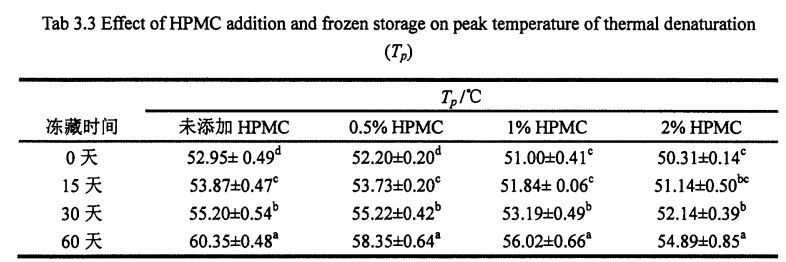
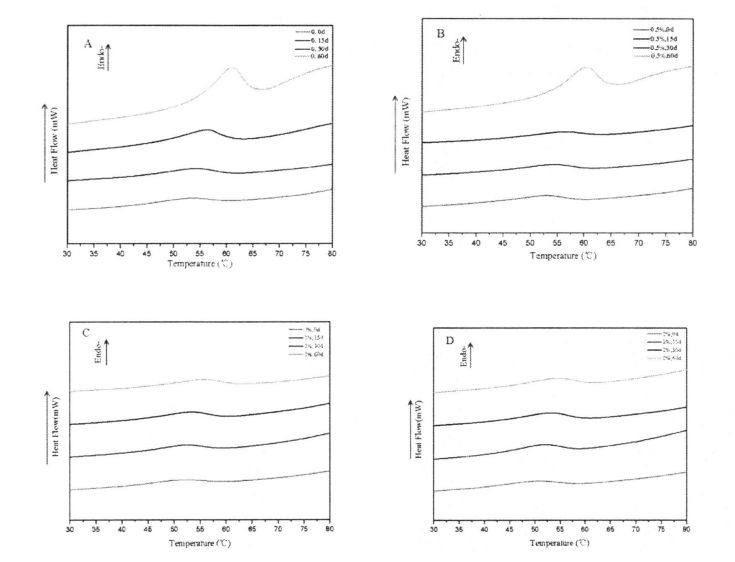
Fig 3.2 Typical DSC thermograms of gluten proteins with 0%HPMC(A);with O.5%HPMC(B); with 1%HPMC(C);with 2%HPMC(D)after different time of frozen storage,from 0d to 60d indicated from the lowest curve to the highest one in each graph. Note: A is the DSC curve of wheat gluten without adding HPMC; B is the addition of O. DSC curve of wheat gluten with 5% HPMC; C is the DSC curve of wheat gluten with 1% HPMC; D yra kviečių glitimo DSC kreivė, turinti 2% HPMC 3.3.3 HPMC papildomo kiekio ir užšalimo laiko poveikis laisvojo sulfhidrilo kiekio (C-Sh) tarpmolekulinėms ir intramolekulinėms kovalentinėms jungtims yra labai svarbūs tešlos tinklo struktūros stabilumui. A disulfide bond (-SS-) is a covalent linkage formed by dehydrogenation of two free sulfhydryl groups (.SH). Gluteninas yra sudarytas iš glutenino ir gliadino. Pirmasis gali sudaryti intramolekulinius ir tarpmolekulinius disulfidinius ryšius, o antrasis gali sudaryti tik intramolekulinius disulfidinius ryšius [1241], todėl disulfido jungtys yra intramolekulinės/intermolekulinės disulfido jungtys. important way of cross-linking. Palyginti su 0% pridėjimu, O. 5% ir 1% HPMC C-SH be užšalimo gydymo ir glitimo C-Sh po 60 dienų užšalimo turi skirtingą laipsnį. Specifically, the face with no HPMC added gluten C. SH increased by 3.74 "mol/g to 8.25 "mol/g, while C.sh, shellfish, with gluten supplemented with 0.5% and 1% HPMC increased by 2.76 "mol/g to 7.25""mol/g and 1.33 "mol/g to 5.66 "mol/g (Fig. 3.3). Zhao, et a1. (2012) found that after 120 days Šaldytos saugyklos laisvo tiolio grupių kiekis žymiai padidėjo [1071. Verta paminėti, kad glitimo baltymo C-Sh-SH buvo žymiai mažesnis nei kitų užšaldytų laikymo laikotarpių, kai užšalimo laikotarpis buvo 15 dienų, o tai gali būti priskiriama glitimo baltymų struktūros užšalimo poveikiui, o tai sukelia daugiau nei tarpmolekulinių ir intramololalekulinių ryšių, o tai buvo tarpmolekuliniai ir intramololalfidiniai ryšiai, kurie buvo slidinėjantys sliekai. [1161.
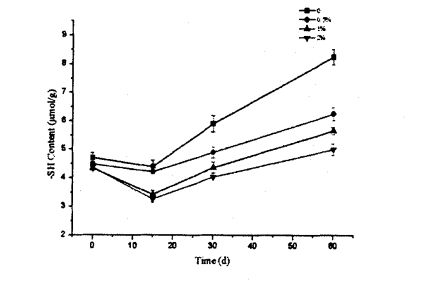
Fig 3.3 Effect of HPMC addition and frozen storage on the content of free-SH for gluten proteins As mentioned above, freezable water can form ice crystals at low temperatures and distribute in the interstices of the gluten network. Therefore, with the prolongation of freezing time, the ice crystals become larger, which squeezes the gluten protein structure more seriously, and leads to the breakage of some intermolecular and intramolecular disulfide bonds, which increases the content of free sulfhydryl groups. On the other hand, the experimental results show that HPMC can protect the disulfide bond from the extrusion damage of ice crystals, thereby inhibiting the depolymerization process of gluten protein. 3.3.4 Effects of HPMC addition amount and freezing storage time on transverse relaxation time (T2) of wet gluten mass The distribution of Transverse Relaxation Time (T2) can reflect the model and dynamic process of water migration in food materials [6]. Figure 3.4 shows the distribution of wet gluten mass at 0 and 60 days with different HPMC additions, including 4 main distribution intervals, namely 0.1.1 ms (T21), 1.10 ms (T22), 10.100 ms (dead;) and 1 00-1 000 ms (T24). Bosmans et al. (2012) found a similar distribution of wet gluten mass [1261], and they suggested that protons with relaxation times below 10 ms could be classified as rapidly relaxing protons, which are mainly derived from poor mobility the bound water, therefore, may characterize the relaxation time distribution of bound water bound to a small amount of starch, while Dang may characterize the relaxation time distribution of bound water bound to gluten protein. In addition, Kontogiorgos (2007) - t11¨, the "strands" of the gluten protein network structure are composed of several layers (Sheets) about 5 nm apart, and the water contained in these layers is limited water (or Bulk water, phase water), the mobility of this water is between the mobility of bound water and free water. Ir T23 gali būti priskiriamas riboto vandens atsipalaidavimo laiko pasiskirstymui. The T24 distribution (>100 ms) has a long relaxation time, so it characterizes free water with strong mobility. This water exists in the pores of the network structure, and there is only a weak capillary force with the gluten protein system.
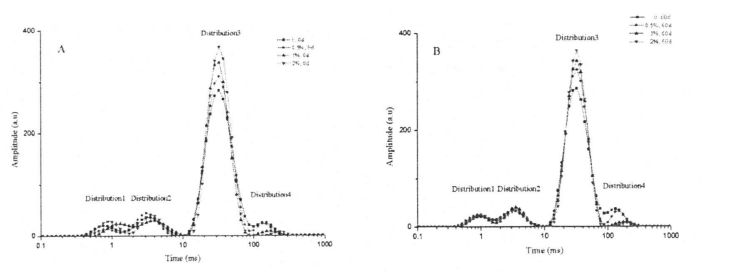
3.4 pav.
Pastaba: A ir B žymi skersinį atsipalaidavimo laiko (n) šlapio glitimo pasiskirstymo kreives su skirtingu HPMC turiniu, pridedamu atitinkamai 0 dienas ir 60 dienų, kai užšalimo laikymas
Comparing the wet gluten doughs with different addition amounts of HPMC stored in frozen storage for 60 days and unfrozen storage respectively, it was found that the total distribution area of T21 and T24 did not show a significant difference, indicating that the addition of HPMC did not significantly increase the relative amount of bound water. content, which may be due to the fact that the main water-binding substances (gluten protein with a small amount of starch) were not significantly changed by the addition of a small amount of HPMC. Kita vertus, palyginus šlapio glitimo masės T21 ir T24 pasiskirstymo vietas su tokiu pat kiekiu HPMC, pridedant prie skirtingo užšalimo laikymo laiko, taip pat nėra reikšmingo skirtumo, o tai rodo, kad surištas vanduo yra gana stabilus užšalimo laikymo proceso metu ir neturi neigiamos įtakos aplinkai. Pokyčiai yra mažiau jautrūs ir mažiau paveikti.
Tačiau buvo akivaizdžių Šlapio glitimo masės T23 pasiskirstymo, kuris nebuvo užšaldytas ir juose buvo skirtingi HPMC papildymai, pasiskirstymo skirtumai ir plotas, o padidėjus padidėjusio T23 pasiskirstymo aukštyje ir plotui padidėjo (3.4 pav.). This change shows that HPMC can significantly increase the relative content of limited water, and it is positively correlated with the added amount within a certain range. Be to, prailginus užšalimo laikymo laiką, šlapio glitimo masės T23 pasiskirstymo aukštis ir plotas tuo pačiu HPMC kiekiu sumažėjo iki skirtingo laipsnio. Todėl, palyginti su surištu vandeniu, ribotas vanduo parodė tam tikrą poveikį užšalimo laikymui. Sensitivity. Ši tendencija rodo, kad glitimo baltymų matricos ir uždaromo vandens sąveika tampa silpnesnė. Taip gali būti todėl, kad užšalimo metu eksponuojamos daugiau hidrofobinių grupių, o tai atitinka šiluminės denatūracijos smailės temperatūros matavimus. In particular, the height and area of the T23 distribution for the wet gluten mass with 2% HPMC addition did not show a significant difference. This indicates that HPMC can limit the migration and redistribution of water, and can inhibit the transformation of the water state from the restricted state to the free state during the freezing process.
Be to, šlapio glitimo masės T24 pasiskirstymo aukštis ir plotas su skirtingu HPMC kiekiu reikšmingai skyrėsi (3.4 pav., A), o santykinis laisvojo vandens kiekis buvo neigiamai koreliuojamas su pridėtu HPMC kiekiu. Tai yra visiškai priešinga DANG paskirstymui. Todėl ši variacijos taisyklė rodo, kad HPMC turi vandens sulaikymo pajėgumą ir paverčia laisvą vandenį į uždarą vandenį. Tačiau po 60 dienų užšalimo T24 pasiskirstymo aukštis ir plotas padidėjo iki skirtingo laipsnio, o tai parodė, kad vandens būsena iš riboto vandens pasikeitė į laisvai tekančią būseną užšalimo proceso metu. Tai daugiausia lemia glitimo baltymų konformacijos pasikeitimas ir „sluoksnio“ vieneto sunaikinimas glitimo struktūroje, o tai keičia jame esančio uždaros vandens būseną. Nors DSC nustatytas šaldyto vandens kiekis taip pat padidėja, prailginant užšalimo laikymo laiką, tačiau dėl abiejų matavimo metodų ir apibūdinimo principų skirtumų, šaldytinas vanduo ir laisvas vanduo nėra visiškai lygiaverčiai. Šlapio glitimo masei, pridėtai su 2% HPMC, po 60 dienų užšalimo laikymo nė vienas iš keturių pasiskirstymų neparodė reikšmingų skirtumų, tai rodo, kad HPMC gali efektyviai išlaikyti vandens būseną dėl savo vandens laikymo savybių ir sąveikos su glitimu. ir stabilus likvidumas.
3.3.5 HPMC papildomo kiekio ir užšalimo laikymo poveikis antrinei glitimo baltymų struktūrai
Generally speaking, the secondary structure of protein is divided into four types, α-Spiral, β-folded, β-Corners and random curls. Svarbiausi antriniai ryšiai, skirti formuoti ir stabilizuoti baltymų erdvinę konformaciją, yra vandenilio jungtys. Todėl baltymų denatūracija yra vandenilio ryšių laužymo ir konformacinių pokyčių procesas.
Fourier transform infrared spectroscopy (FT-IR) has been widely used for high-throughput determination of the secondary structure of protein samples. Būdingos baltymų infraraudonųjų spindulių spektro juostos daugiausia apima „Amide I“ juostą (1700,1600 cm-1), Amide II juostą (1600,1500 cm-1) ir Amide III juostą (1350,1200 cm-1). Correspondingly, the amide I band the absorption peak originates from the stretching vibration of the carbonyl group (-C=O-.), the amide II band is mainly due to the bending vibration of the amino group (-NH-) [1271], and the amide III band is mainly due to the amino bending vibration and .CN-.Synchronous compound vibration in the same plane of bond stretching vibration, and has a high sensitivity to changes in protein secondary structure [128'1291. Although the above three characteristic bands are all characteristic infrared absorption peaks of proteins, the specific In other words, the absorption intensity of amide II band is lower, so the semi-quantitative accuracy of protein secondary structure is poor; while the peak absorption intensity of amide I band is higher, so many researchers analyze the secondary structure of protein by this band [ 1301, but the absorption peak of water and the amide I band are overlapped at about 1640 cm. 1 wavenumber (Overlapped), which in turn affects the accuracy of the results. Therefore, the interference of water limits the determination of the amide I band in protein secondary structure determination. In this experiment, in order to avoid the interference of water, the relative contents of four secondary structures of gluten protein were obtained by analyzing the amide III band. Didžiausia padėtis (bangos skaičiaus intervalas)
Tab 3.4 Peak Pozicijos ir antrinių struktūrų priskyrimas kilo iš Amide III juostos FT-IR spektruose

Figure 3.5 is the infrared spectrum of the amide III band of gluten protein added with different contents of HPMC for 0 days after being frozen for 0 days after deconvolution and fitting of the second derivative. (2001) applied the second derivative to fit the deconvoluted peaks with similar peak shapes [1321]. Norint kiekybiškai įvertinti kiekvienos antrinės struktūros santykinius turinio pokyčius, 3.5 lentelėje apibendrintas keturių glitimo baltymų keturių antrinių struktūrų santykinis procentinis kiekis su skirtingu užšalimo laiku ir skirtingais HPMC papildymais (atitinkamas smailės integralo plotas/bendras plotas).
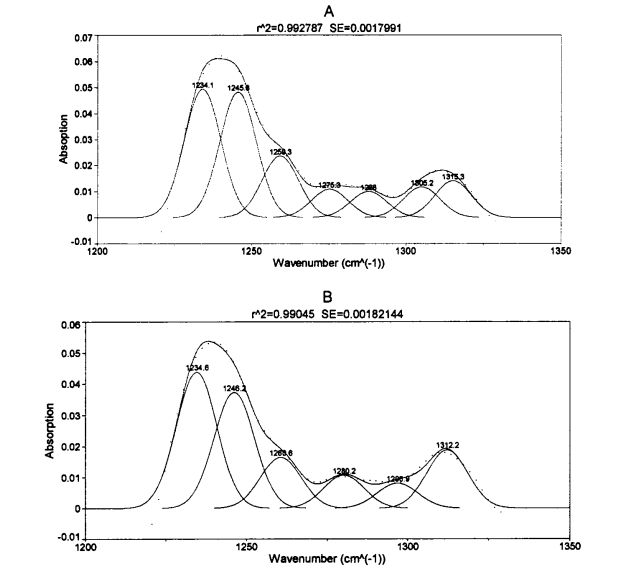
With the prolongation of frozen storage time, the secondary structure of gluten protein with different additions of HPMC changed to different degrees. Galima pastebėti, kad tiek užšaldytas, tiek pridedant HPMC, daro įtaką antrinei glitimo baltymų struktūrai. Regardless of the amount of HPMC added, B. The folded structure is the most dominant structure, accounting for about 60%. Po 60 dienų užšaldyto laikymo pridėkite 0%, OB glitimo - 5% ir 1% HPMC. The relative content of folds increased significantly by 3.66%, 1.87% and 1.16%, respectively, which was similar to the results determined by Meziani et al. (2011) [l33J]. However, there was no significant difference during frozen storage for gluten supplemented with 2% HPMC. Be to, kai sušalęs 0 dienų, padidėjus HPMC pridėjimui, p. The relative content of folds increased slightly, especially when the addition amount was 2%, p. The relative content of folds increased by 2.01%. D. Sulankstytą struktūrą galima suskirstyti į tarpmolekulinius p. Folding (caused by aggregation of protein molecules), antiparallel p. Folded and parallel p. Trys substruktūros yra sulankstytos, ir sunku nustatyti, kuri substrukcija vyksta užšalimo proceso metu
pasikeitė. Kai kurie tyrėjai mano, kad padidėjęs B tipo struktūros santykinis kiekis padidins sterinės konformacijos nelankstumą ir hidrofobiškumą [41], o kiti tyrėjai mano, kad p. The increase in folded structure is due to part of the new β-Fold formation is accompanied by a weakening of the structural strength maintained by hydrogen bonding [421]. β- The increase in the folded structure indicates that the protein is polymerized through hydrophobic bonds, which is consistent with the results of the peak temperature of thermal denaturation measured by DSC and the distribution of transverse relaxation time measured by low-field nuclear magnetic resonance. Protein denaturation. On the other hand, added 0.5%, 1% and 2% HPMC gluten protein α-whirling. Santykinis spiralės kiekis padidėjo atitinkamai 0,95%, 4,42% ir 2,03%, pratęsiant užšalimo laiką, kuris atitinka Wang, ET A1. (2014) found similar results [134]. 0 glitimo be pridėto HPMC. There was no significant change in the relative content of helix during the frozen storage process, but with the increase of the addition amount of freeze for 0 days. Santykinis α-WHIRLING struktūrų kiekis buvo reikšmingi.
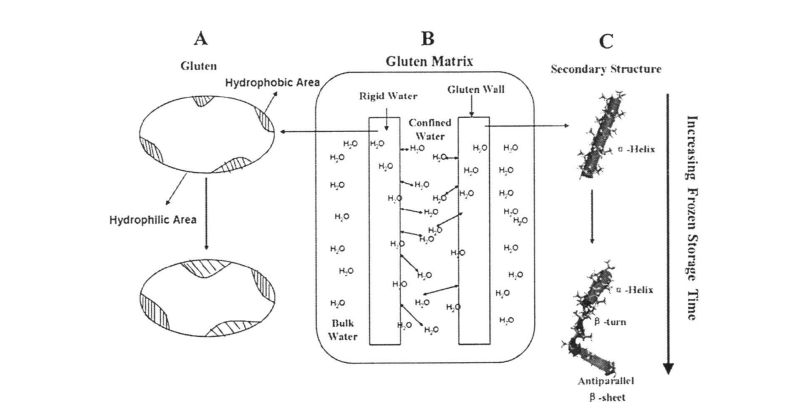
3.6 pav. Hidrofobinio fragmento ekspozicijos schema (A) , Vandens perskirstymo (B) , ir antrinių struktūrinių pokyčių (C) glitimo matricoje didėjant užšaldytam laikymo laikui 【31'138】
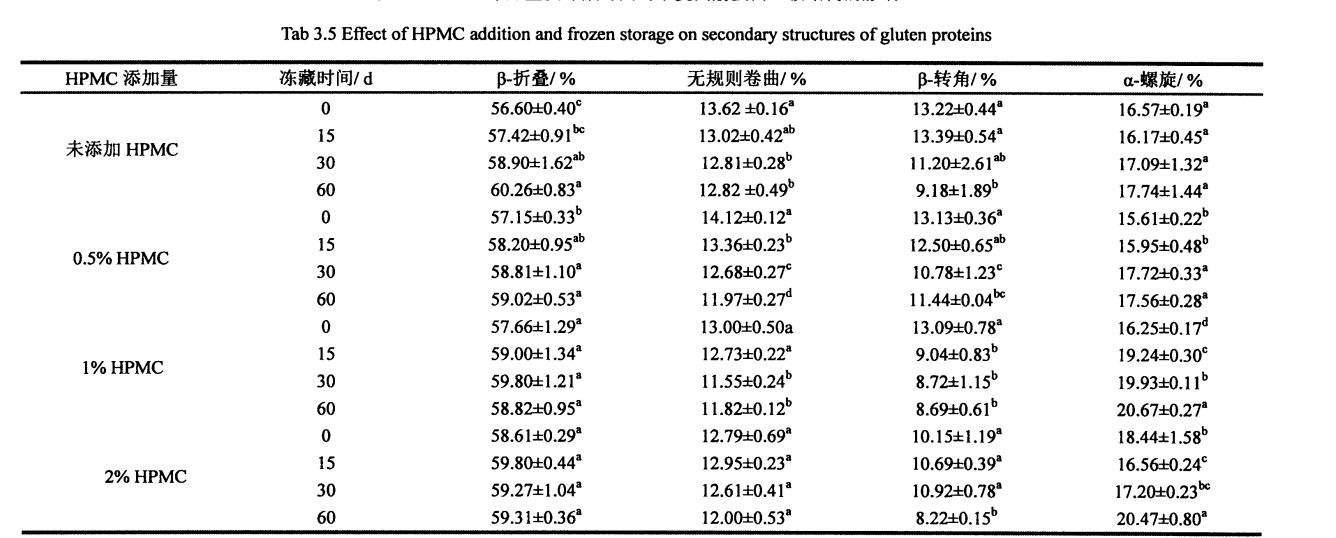
All samples with the extension of freezing time, p. The relative contents of the corners were significantly reduced. This shows that β-turn is very sensitive to freezing treatment [135. 1361], ir ar pridedama HPMC, ar ne, neturi jokio poveikio. Wellner, et A1. (2005) proposed that the β-chain turn of gluten protein is related to the β-turn space domain structure of the glutenin polypeptide chain [l 37]. Except that the relative content of random coil structure of gluten protein added with 2% HPMC had no significant change in frozen storage, the other samples were significantly reduced, which may be caused by the extrusion of ice crystals. In addition, when frozen for 0 days, the relative contents of α-helix, β-sheet and β-turn structure of gluten protein added with 2% HPMC were significantly different from those of gluten protein without HPMC. This may indicate that there is an interaction between HPMC and gluten protein, forming new hydrogen bonds and then affecting the conformation of the protein; or HPMC absorbs the water in the pore cavity of the protein space structure, which deforms the protein and leads to more changes between the subunits. uždaryti. The increase of the relative content of β-sheet structure and the decrease of the relative content of β-turn and α-helix structure are consistent with the above speculation. During the freezing process, the diffusion and migration of water and the formation of ice crystals destroy the hydrogen bonds that maintain the conformational stability and expose the hydrophobic groups of proteins. In addition, from the perspective of energy, the smaller the energy of the protein, the more stable it is. At low temperature, the self-organization behavior (folding and unfolding) of protein molecules proceeds spontaneously and leads to conformational changes.
3.3.6.
Baltymų molekulės apima ir hidrofilines, ir hidrofobines grupes. Paprastai baltymų paviršių sudaro hidrofilinės grupės, kurios gali surišti vandenį per vandenilio jungimąsi, kad sudarytų hidratacijos sluoksnį, kad baltymų molekulės neleistų aglomeruoti ir palaikyti jų konformacinį stabilumą. Baltymų viduje yra daugiau hidrofobinių grupių, kad būtų suformuota ir palaikoma baltymo antrinė ir tretinė struktūra per hidrofobinę jėgą. Baltymų denatūraciją dažnai lydi hidrofobinių grupių ekspozicija ir padidėjęs paviršiaus hidrofobiškumas.

After 60 days of frozen storage, add 0%, O. The surface hydrophobicity of gluten with 5%, 1% and 2% HPMC increased by 70.53%, 55.63%, 43.97% and 36.69%, respectively (Table 3.6). In particular, the surface hydrophobicity of the gluten protein without adding HPMC after being frozen for 30 days has increased significantly (P<0.05), and it is already greater than the surface of the gluten protein with 1% and 2% HPMC added after freezing for 60 days Hydrophobicity. At the same time, after 60 days of frozen storage, the surface hydrophobicity of gluten protein added with different contents showed significant differences. However, after 60 days of frozen storage, the surface hydrophobicity of gluten protein added with 2% HPMC only increased from 19.749 to 26.995, which was not significantly different from the surface hydrophobicity value after 30 days of frozen storage, and was always lower than other the value of the surface hydrophobicity of the sample. This indicates that HPMC can inhibit the denaturation of gluten protein, which is consistent with the results of DSC determination of the peak temperature of heat deformation. Taip yra todėl, kad HPMC gali slopinti baltymų struktūros sunaikinimą perkristalindamas ir dėl jo hidrofiliškumo,
3.3.7.
Nuolatiniame glitimo tinklo struktūroje yra daug porų, skirtų palaikyti anglies dioksido dujas, kurias sukelia mielės, kai tešlos įrodymo metu. Therefore, the strength and stability of the gluten network structure are very important to the quality of the final product, such as specific volume, quality, etc. Structure and sensory assessment. Mikroskopiniu požiūriu medžiagos paviršiaus morfologija gali būti stebima nuskaitymo elektronų mikroskopija, kuri suteikia praktinį pagrindą glitimo tinklo struktūros pokyčiams pokyčiams užšalimo proceso metu.
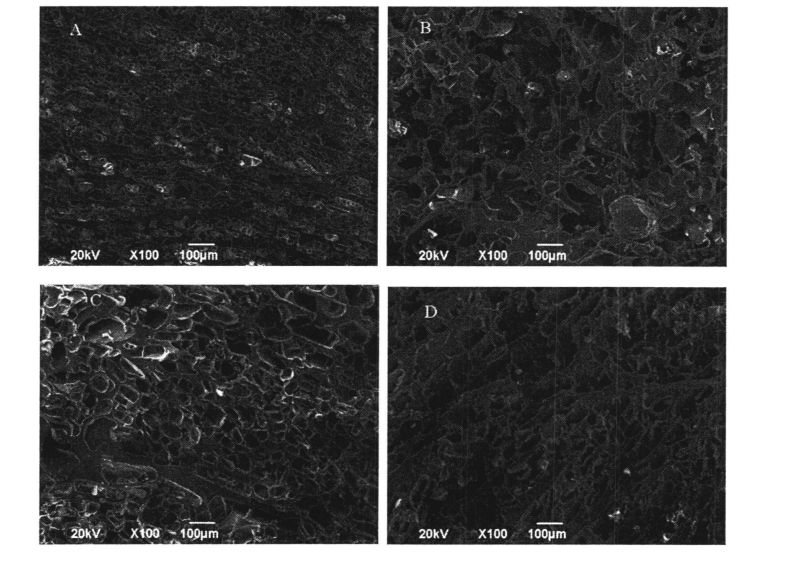
3.7 pav.
Note: A is the microstructure of gluten network without adding HPMC and frozen for 0 days; B yra glitimo tinklo mikrostruktūra, nepridedant HPMC ir 60 dienų užšaldyta; C is the microstructure of gluten network with 2% HPMC added and frozen for 0 days :D is the gluten network microstructure with 2% HPMC added and frozen for 60 days
Po 60 dienų užšaldyto laikymo buvo reikšmingai pasikeitusi šlapio glitimo masės be HPMC mikrostruktūra (3.7 pav., AB). 0 dienų glitimo mikrostruktūros, kurių 2% arba 0% HPMC
Maža apytikslė porėta kempine panaši morfologija. However, after 60 days of frozen storage, the cells in the gluten microstructure without HPMC became larger in size, irregular in shape, and unevenly distributed (Fig. 3.7, A, B), mainly due to the This is caused by the fracture of the "wall", which is consistent with the measurement results of the free thiol group content, that is, during the freezing process, the ice crystal squeezes and breaks the disulfide bond, which affects the strength and integrity of the structure. Kaip pranešė Kontogiorgos ir Goff (2006) ir Kontogiorgos (2007), dėl glitimo tinklo intersticinių regionų yra suspausti dėl užšalimo-spenelio, dėl kurių sutrikdo struktūriniai [138. 1391]. Be to, dėl dehidratacijos ir kondensacijos kempinėje struktūroje buvo sukurta santykinai tanki pluoštinė struktūra, o tai gali būti priežastis, dėl kurios sumažėjo laisvojo tiolio kiekis po 15 dienų užšaldyto laikymo, nes buvo sukurta daugiau disulfidinių ryšių ir buvo sukurta užšaldyti. The gluten structure was not severely damaged for a shorter time, which is consistent with Wang, et a1. (2014) observed similar phenomena [134]. At the same time, the destruction of the gluten microstructure leads to freer water migration and redistribution, which is consistent with the results of low-field time-domain nuclear magnetic resonance (TD-NMR) measurements. Some studies [140, 105] reported that after several freeze-thaw cycles, the gelatinization of rice starch and the structural strength of the dough became weaker, and the water mobility became higher. Nonetheless, after 60 days of frozen storage, the microstructure of gluten with 2% HPMC addition changed less, with smaller cells and more regular shapes than gluten without HPMC addition (Fig. 3.7, B, D). This further indicates that HPMC can effectively inhibit the destruction of gluten structure by recrystallization.
Šis eksperimentas ištyrė šlapio glitimo tešlos ir glitimo baltymų reologiją, pridedant HPMC su skirtingu kiekiu (0%, 0,5%, 1%ir 2%) užšalimo kaupimo metu (0, 15, 30 ir 60 dienų). properties, thermodynamic properties, and effects of physicochemical properties. The study found that the change and redistribution of water state during the freezing storage process significantly increased the freezable water content in the wet gluten system, which led to the destruction of the gluten structure due to the formation and growth of ice crystals, and ultimately caused the processing properties of the dough to be different. Deterioration of product quality. The results of frequency scanning showed that the elastic modulus and viscous modulus of the wet gluten mass without adding HPMC decreased significantly during the freezing storage process, and the scanning electron microscope showed that its microstructure was damaged. The content of free sulfhydryl group was significantly increased, and its hydrophobic group was more exposed, which made the thermal denaturation temperature and surface hydrophobicity of gluten protein significantly increased. However, the experimental results show that the addition of I-IPMC can effectively inhibit the changes in the structure and properties of wet gluten mass and gluten protein during freezing storage, and within a certain range, this inhibitory effect is positively correlated with the addition of HPMC. This is because HPMC can reduce the mobility of water and limit the increase of the freezable water content, thereby inhibiting the recrystallization phenomenon and keeping the gluten network structure and the spatial conformation of the protein relatively stable. This shows that the addition of HPMC can effectively maintain the integrity of the frozen dough structure, thereby ensuring product quality.
4 skyrius HPMC papildymo poveikis krakmolo struktūrai ir savybėms, esant užšaldytam laikymui
Krakmolas yra grandininis polisacharidas, turintis gliukozę kaip monomerą. key) two types. From a microscopic point of view, starch is usually granular, and the particle size of wheat starch is mainly distributed in two ranges of 2-10 pro (B starch) and 25-35 pm (A starch). From the perspective of crystal structure, starch granules include crystalline regions and amorphous regions (je, non-crystalline regions), and the crystal forms are further divided into A, B, and C types (it becomes V-type after complete gelatinization). Generally, the crystalline region consists of amylopectin and the amorphous region consists mainly of amylose. Taip yra todėl, kad, be C grandinės (pagrindinės grandinės), amilopektinas taip pat turi šonines grandines, sudarytas iš B (šakos grandinės) ir C (anglies grandinės) grandinių, dėl kurių amilopektinas atrodo „panašus į medį“ žaliame krakmole. The shape of the crystallite bundle is arranged in a certain way to form a crystal.
Among them, starch gelatinization refers to the process in which starch granules are gradually disintegrated and hydrated in a system with high water content and under heating conditions. It can be roughly divided into three main processes. 1) Reversible water absorption stage; before reaching the initial temperature of gelatinization, the starch granules in the starch suspension (Slurry) keep their unique structure unchanged, and the external shape and internal structure basically do not change. Only very little soluble starch is dispersed in the water and can be restored to its original state. 2) The irreversible water absorption stage; Pakilus temperatūrai, vanduo patenka į tarpą tarp krakmolo kristalitų pluoštų, negrįžtamai sugeria didelį kiekį vandens, todėl krakmolas išsipučia, tūris kelis kartus plečiasi, o vandenilio ryšiai tarp krakmolo molekulių nutrūksta. It becomes stretched and the crystals disappear. At the same time, the birefringence phenomenon of starch, that is, the Maltese Cross observed under a polarizing microscope, begins to disappear, and the temperature at this time is called the initial gelatinization temperature of starch. 3) krakmolo granulių dezintegracijos stadija; starch molecules completely enter the solution system to form starch paste (Paste/Starch Gel), at this time the viscosity of the system is the largest, and the birefringence phenomenon completely disappears, and the temperature at this time is called the complete starch gelatinization temperature, the gelatinized starch is also called α-starch [141]. When the dough is cooked, the gelatinization of starch endows the food with its unique texture, flavor, taste, color, and processing characteristics.
Apskritai krakmolo želatinizavimui įtakos turi krakmolo šaltinis ir tipas, santykinis amilozės ir amilopektino kiekis krakmole, nesvarbu, ar krakmolas yra modifikuotas, ir modifikavimo metodas, pridedant kitų egzogeninių medžiagų, ir dispersijos sąlygos (tokios kaip druskos jonų rūšių ir koncentracijos, ph vertės, temperatūros, drėgmės ir tt) [142-150]. Therefore, when the structure of starch (surface morphology, crystalline structure, etc.) is changed, the gelatinization properties, rheological properties, aging properties, digestibility, etc. of starch will be affected accordingly.
Daugybė tyrimų parodė, kad mažėja krakmolo pastos gelio stiprumas, jis nesunku sensta, o jo kokybė blogėja esant užšalimo laikymui, pavyzdžiui, kanalas ir ET A1. (2005) ištyrė užšalimo temperatūros poveikį bulvių krakmolo tyrės kokybei; Ferrero, et A1. (1993) ištyrė užšalimo greičio ir įvairių tipų priedų poveikį kviečių ir kukurūzų krakmolo pastų savybėms [151–156]. Tačiau yra palyginti nedaug pranešimų apie šaldyto saugojimo poveikį krakmolo granulių (vietinio krakmolo) struktūrai ir savybėms, kurias reikia toliau ištirti. Šaldyta tešla (išskyrus iš anksto paruoštą užšalusią tešlą) yra nevalatinizuotų granulių pavidalu, esant užšalusiam laikymui. Todėl, ištirti vietinio krakmolo struktūrą ir struktūrinius pokyčius pridedant HPMC, turi tam tikrą poveikį užšaldytos tešlos apdorojimo savybėms pagerinti. reikšmė.
In this experiment, by adding different HPMC contents (0, 0.5%, 1%, 2%) to the starch suspension, the amount of HPMC added during a certain freezing period (0, 15, 30, 60 days) was studied. ant krakmolo struktūros ir jo želatinizacijos gamtos įtakos.
4.2 Eksperimentinės medžiagos ir metodai
Wheat Starch Binzhou Zhongyu Food Co., Ltd.; HPMC Aladdin (Šanchajus) „Chemical Reagent Co., Ltd“;
BSAL24S elektroninis balansas
BC/BD-272SC šaldytuvas
„BCD-201lct“ šaldytuvas
SX2.4.10 Mufelių krosnis
KDC. 160 val
D/max2500v X tipas. Ray difraktometras
SX2.4.10 Mufelių krosnis
Gamintojas
„Hefei Meiling Co.“, Ltd.
Anhui Zhongke Zhongjia Scientific Instrument Co., Ltd.
„Rigaku Manufacturing Co., Ltd.“
4.2.3 Eksperimentinis metodas
4.2.3.1
Weigh 1 g of starch, add 9 mL of distilled water, fully shake and mix to prepare a 10% (w/w) starch suspension. Then place the sample solution. 18 ℃ refrigerator, frozen storage for 0, 15 d, 30 d, 60 d, of which 0 day is the fresh control. Pridėkite 0,5%, 1%, 2%(m/m) HPMC, o ne atitinkamą kokybės krakmolą, kad paruoštumėte mėginius su skirtingais papildomais kiekiais, o likę gydymo metodai nesikeičia.
4.2.3.2 reologinės savybės
Išimkite aukščiau paminėtus mėginius, apdorotus atitinkamu užšalimo laiku, pusiausvyrą 4 ° C temperatūroje 4 valandas, o po to pereikite prie kambario temperatūros, kol jie visiškai atšildys.
(1) krakmolo želatinizacijos charakteristikos
In this experiment, a rheometer was used instead of a fast viscometer to measure the gelatinization characteristics of starch. See Bae et a1. (2014) method [1571] with slight modifications. Specifiniai programos parametrai nustatomi taip: naudokite 40 malūno skersmens plokštelę, tarpas (tarpas) yra 1000 mm, o sukimosi greitis yra 5 rad/s; I) incubate at 50 °C for 1 min; ii) at 5. C/min heated to 95°C; iii) laikomas 95 ° C temperatūroje 2,5 min., iv), tada atvėsinama iki 50 ° C 5 ° C/min.; v) 5 minutes laikomas 50 ° C temperatūroje.
Draw 1.5 mL of sample solution and add it to the center of the rheometer sample stage, measure the gelatinization properties of the sample according to the above program parameters, and obtain the time (min) as the abscissa, the viscosity (Pa s) and the temperature (°C) as the starch gelatinization curve of the ordinate. According to GB/T 14490.2008 [158], the corresponding gelatinization characteristic indicators—gelatinization peak viscosity (field), peak temperature (Ang), minimum viscosity (high), final viscosity (ratio) and decay value (Breakdown) are obtained. Vertė, bv) ir regeneracijos reikšmė (nesėkmės reikšmė, SV), kur, skilimo reikšmė = didžiausias klampumas - minimalus klampumas; setback value = final viscosity - minimum viscosity. Kiekvienas mėginys buvo pakartotas tris kartus.
(2) Krakmolo pastos pastovus srauto testas
The above gelatinized starch paste was subjected to the Steady Flow Test, according to the method of Achayuthakan & Suphantharika [1591, the parameters were set to: Flow Sweep mode, stand at 25°C for 10 min, and the shear rate scan range was 1) 0.1 S one. 100s ~, 2) 100s ~. 0.1 S~, the data is collected in logarithmic mode, and 10 data points (plots) are recorded every 10 times the shear rate, and finally the shear rate (Shear Rate, SI) is taken as the abscissa, and the shear viscosity ( Viscosity, pa ·s) is the rheological curve of the ordinate. Use Origin 8.0 to perform nonlinear fitting of this curve and obtain the relevant parameters of the equation, and the equation satisfies the power law (Power Law), that is, t/=K), nI, where M is the shear viscosity (pa ·s), K is the consistency coefficient (Pa ·s), is the shear rate (s. 1), and n is the flow behavior index (Flow Behavior Index, dimensionless).
4.2.3.3 krakmolo pastos gelio savybės
(1) Mėginio paruošimas
Paimkite 2,5 g amiloido ir sumaišykite jį su distiliuotu vandeniu, kurio santykis yra 1: 2, kad gautų krakmolo pieną. Užšaldykite 18 ° C temperatūroje 15 dienų, 30 d ir 60 d. Pridėkite 0,5, 1, 2% HPMC (m/m), kad pakeistumėte tos pačios kokybės krakmolą, o kiti paruošimo būdai liko nepakitę. After the freezing treatment is completed, take it out, equilibrate at 4 °C for 4 h, and then thaw at room temperature until it is tested.
(3) krakmolo gelio stiprumas (gelio stiprumas)
Paimkite 1,5 ml mėginio tirpalo ir padėkite jį ant reometro mėginio stadijos („Discovery.R3“), paspauskite 40 m/N plokštelę, kurios skersmuo yra 1500 mm, ir pašalinkite mėginio perteklių ir toliau nuleiskite plokštelę iki 1000 mm, ant variklio, greitis buvo nustatytas iki 5 rad/s ir pasuktą 1 min. The temperature scan starts at 25°C and ends at 5. C/min was raised to 95°C, kept for 2 min, and then lowered to 25°C at 5"C/min.
A layer of petrolatum was lightly applied to the edge of the starch gel obtained above to avoid water loss during subsequent experiments. Atsižvelgiant į „Abebe & Ronda“ metodą [1601], pirmiausia buvo atliktas virpesių deformacijos valymas, siekiant nustatyti linijinį viskoelastingumo sritį (LVR), deformacijos valymo diapazonas buvo 0,01–100%, dažnis buvo 1 Hz, o valymas buvo pradėtas stovėti 25 ° C temperatūroje 10 min.
Tada nušluokite virpesių dažnį, nustatykite deformacijos kiekį (deformaciją) iki 0,1% (pagal deformacijos valymo rezultatus) ir nustatykite dažnio diapazoną iki O. iki 10 Hz. Each sample was repeated three times.
4.2.3.4 Termodinaminės savybės
(1) Mėginio paruošimas
After the corresponding freezing treatment time, the samples were taken out, thawed completely, and dried in an oven at 40 °C for 48 h. Galiausiai buvo sumalta per 100 metrų sietą, kad būtų gautas kietas miltelių mėginys, skirtas naudoti (tinkamas XRD bandymui). See Xie, et a1. (2014 m.) Mėginių paruošimo ir termodinaminių savybių „1611“ metodas, pasverikite 10 mg krakmolo mėginio į skystą aliuminio tiglį su ultra-mikro analizės balansu, įpilkite 20 mg distiliuoto vandens 1: 2, paspauskite ir uždarykite 4 ° C temperatūroje, lygiaverčiame 24 valandas. Freeze at 18°C (0, 15, 30 and 60 days). Add 0.5%, 1%, 2% (w/w) HPMC to replace the corresponding quality of starch, and other preparation methods remain unchanged. After the freezing storage time is over, take out the crucible and equilibrate at 4 °C for 4 h.
(3) Želatinizacijos temperatūros ir entalpijos pokyčių nustatymas
Atsižvelgiant į tuščią tiglį kaip etaloną, azoto srautas buvo 50 ml/min., Pusiausvyros 20 ° C temperatūroje 5 minutes, o po to kaitinamas iki 100 ° C temperatūroje 5 ° C/min. Finally, the heat flow (Heat Flow, mW) is the DSC curve of the ordinate, and the gelatinization peak was integrated and analyzed by Universal Analysis 2000. Each sample was repeated at least three times.
4.2.3.5 XRD matavimas
Atšildomi užšalę krakmolo mėginiai buvo džiovinami orkaitėje 40 ° C temperatūroje 48 valandas, po to sumalami ir sijojami per 100 metrų sietą, kad gautumėte krakmolo miltelių mėginius. Paimkite tam tikrą kiekį aukščiau pateiktų mėginių, naudokite D/MAX 2500 V tipo X tipą. Kristalų forma ir santykinis kristališkumas buvo nustatyti rentgeno spindulių difraktometru. The experimental parameters are voltage 40 KV, current 40 mA, using Cu. Ks as X. ray source. Kambario temperatūroje nuskaitymo kampo diapazonas yra 30–400, o nuskaitymo greitis-20/min. Relative crystallinity (%) = crystallization peak area/total area x 100%, where the total area is the sum of the background area and the peak integral area [1 62].
4.2.3.6 Krakmolo patinimo galios nustatymas
Paimkite 0,1 g džiovintų, sumaltų ir sijodami amiloidą į 50 ml centrifugos vamzdelį, įpilkite 10 ml distiliuoto vandens, gerai supurtykite, leiskite jam stovėti 0,5 valandos ir tada įdėkite į 95 ° C vandens vonią pastovioje temperatūroje. Po 30 minučių, pasibaigus želatinizavimui, išimkite centrifugos vamzdelį ir 10 minučių padėkite į ledo vonią, kad greitai atvėstumėte. Galiausiai 20 minučių centrifuga esant 5000 aps./min., Ir supilkite supernatantą, kad gautumėte nuosėdas. Swelling Power=precipitation mass/sample mass [163].
4.2.3.7 Duomenų analizė ir apdorojimas
Visi eksperimentai buvo pakartoti bent tris kartus, jei nenurodyta kitaip, o eksperimentiniai rezultatai buvo išreikšti kaip vidurkis ir standartinis nuokrypis. SPSS Statistic 19 was used for analysis of variance (Analysis of Variance, ANOVA) with a significance level of 0.05; correlation charts were drawn using Origin 8.0.
4.3 Analizė ir diskusija
Remiantis GB 50093.2010, GB/T 5009.9.2008, GB 50094.2010 (78 -S0), pagrindiniai kviečių krakmolo komponentai - drėgmės, amilozės/amilopektino ir pelenų kiekis. Rezultatai parodyti 4 lentelėje. 1 parodyta.
Bakstelėkite 4.1 Kviečių krakmolo sudedamosios dalies turinys

The starch suspension with a certain concentration is heated at a certain heating rate to make the starch gelatinized. Pradėjus želatinizuoti, drumstis skystis pamažu tampa pastas dėl krakmolo išsiplėtimo, o klampumas nuolat didėja. Vėliau krakmolo granulės plyšta, o klampumas mažėja. Kai pastas atvėsinama tam tikru aušinimo greičiu, pasta gelis ir klampumo vertė dar labiau padidės. Klampumo vertė, kai ji atvėsinama iki 50 ° C, yra galutinė klampos vertė (4.1 pav.).
Table 4.2 lists the influence of several important indicators of starch gelatinization characteristics, including gelatinization peak viscosity, minimum viscosity, final viscosity, decay value and appreciation value, and reflects the effect of HPMC addition and freezing time on starch paste. Cheminių savybių poveikis. The experimental results show that the peak viscosity, the minimum viscosity and the final viscosity of starch without frozen storage increased significantly with the increase of HPMC addition, while the decay value and recovery value decreased significantly. Specifically, the peak viscosity gradually increased from 727.66+90.70 CP (without adding HPMC) to 758.51+48.12 CP (adding 0.5% HPMC), 809.754-56.59 CP (adding 1 %HPMC), and 946.64+9.63 CP (adding 2% HPMC); the minimum viscosity was increased from 391.02+18.97 CP (blank not adding) to 454.95+36.90 (adding O .5% HPMC), 485.56+54.0.5 (add 1% HPMC) and 553.03+55.57 CP (add 2% HPMC); the final viscosity is from 794.62.412.84 CP ( Without adding HPMC) increased to 882.24±22.40 CP (adding 0.5% HPMC), 846.04+12.66 CP (adding 1% HPMC) and 910.884-34.57 CP (adding 2 %HPMC); however, the attenuation value gradually decreased from 336.644-71.73 CP (without adding HPMC) to 303.564-11.22 CP (adding 0.5% HPMC), 324.19±2.54 CP (Add
Su 1% HPMC) ir 393,614–45,94 CP (su 2% HPMC), retrogradacijos vertė sumažėjo nuo 403,60+6,13 CP (be HPMC) iki 427,29+14,50 CP (atitinkamai 0,5% HPMC), 360,484-41,39 cp (15 hpmc) ir 355. CP (pridėta 2% HPMC). This and the addition of hydrocolloids such as xanthan gum and guar gum obtained by Achayuthakan & Suphantharika (2008) and Huang (2009) can increase the gelatinization viscosity of starch while reducing the retrogradation value of starch. Tai daugiausia gali būti todėl, kad HPMC veikia kaip savotiškas hidrofilinis koloidas, o pridėjus HPMC, padidėja želatinizacijos smailės klampumas dėl hidrofilinės grupės šoninėje grandinėje, todėl kambario temperatūroje ji tampa labiau hidrofilinė nei krakmolo granulės. Be to, HPMC šiluminio želatinizacijos proceso (termogeliacijos proceso) temperatūros diapazonas yra didesnis nei krakmolo (rezultatai nepateikti), todėl HPMC pridėjimas gali veiksmingai slopinti drastišką klampos sumažėjimą dėl krakmolo granulių dezintegracijos. Todėl mažiausias krakmolo želatinizacijos klampumas ir galutinis klampumas palaipsniui padidėjo didėjant HPMC kiekiui.

The final viscosity of starch suspension without adding HPMC increased from 794.62 ± 12.84 CP (frozen storage for 0 days) to 1413.15 ± 45.59 CP (frozen storage for 60 days). Didžiausias krakmolo suspensijos klampumas padidėjo nuo 882,24 ± 22,40 CP (užšalusi laikymas 0 dienų) iki 1322,86 ± 36,23 CP (užšalusi laikymas 60 dienų); the peak viscosity of starch suspension added with 1% HPMC The viscosity increased from 846.04 ± 12.66 CP (frozen storage 0 days) to 1291.94 ± 88.57 CP (frozen storage for 60 days); and the gelatinization peak viscosity of starch suspension added with 2% HPMC increased from 91 0.88 ± 34.57 CP
(Šaldyta saugykla 0 dienų) padidėjo iki 1198,09 ± 41,15 CP (užšalusi saugykla 60 dienų). Atitinkamai, krakmolo suspensijos silpnėjimo vertė, nepridedant HPMC, padidėjo nuo 336,64 ± 71,73 CP (užšaldytos saugyklos 0 dienų) iki 1027,67 ± 38,72 CP (užšalusi saugykla 60 dienų); Pridedama 0,5 krakmolo suspensijos susilpnėjimo vertė su %HPMC padidėjo nuo 303,56 ± 11,22 CP (užšaldytos saugyklos 0 dienų) iki 833,9 ± 26,45 CP (šaldyta saugykla 60 dienų); Krakmolo suspensija su 1% HPMC pridėta, kad skysčio susilpnėjimo vertė padidėjo nuo 324,19 ± 2,54 CP (užšalimas 0 dienų) iki 672,71 ± 10,96 CP (užšalimas 60 dienų); pridedant 2% HPMC , krakmolo suspensijos silpnėjimo vertė padidėjo nuo 393,61 ± 45,94 CP (užšalimas 0 dienų) iki 557,64 ± 73,77 CP (užšalimas 60 dienų); Nors krakmolo pakaba be HPMC pridėjo, retrogradacijos vertė padidėjo nuo 403,60 ± 6,13 c
P (užšalusi laikymas 0 dienų) iki 856,38 ± 16,20 CP (šaldyta saugykla 60 dienų); the retrogradation value of starch suspension added with 0.5% HPMC increased from 427 .29±14.50 CP (frozen storage for 0 days) increased to 740.93±35.99 CP (frozen storage for 60 days); the retrogradation value of starch suspension added with 1% HPMC increased from 360.48±41. 39 CP (užšalusi saugykla 0 dienų) padidėjo iki 666,46 ± 21,40 CP (užšalusi saugykla 60 dienų); tuo tarpu krakmolo pakabos retrogradacijos vertė, pridedama 2% HPMC, padidėjo nuo 357,85 ± 21,00 CP (užšaldyta saugykla 60 dienų). 0 dienų) padidėjo iki 515,51 ± 20,86 CP (60 dienų užšaldyta).
It can be seen that with the prolongation of freezing storage time, the starch gelatinization characteristics index increased, which is consistent with Tao et a1. F2015) 1. Remiantis eksperimentiniais rezultatais, jie nustatė, kad padidėjus užšalimo-atšildymo ciklų skaičiui, didžiausio klampumo, minimalaus klampumo, galutinio klampumo, skilimo vertės ir krakmolo želatinizacijos retrogradacijos vertės padidėjo iki skirtingo laipsnio [166J]. This is mainly because in the process of freezing storage, the amorphous region (Amorphous Region) of starch granules is destroyed by ice crystallization, so that the amylose (the main component) in the amorphous region (non-crystalline region) undergoes phase separation (Phase. separated) phenomenon, and dispersed in the starch suspension, resulting in an increase in the viscosity of starch gelatinization, and an increase in the related attenuation value and retrogradation value. However, the addition of HPMC inhibited the effect of ice crystallization on starch structure. Todėl padidėjo didžiausias klampumas, minimalus klampumas, galutinis klampumas, skilimo vertė ir retrogradacijos greitis. Padidėjo pridedant HPMC šaldyto laikymo metu. increase and decrease sequentially.

Šlyties greičio poveikis akivaizdžiam skysčio klampumui (šlyties klampumui) buvo ištirtas pastovaus srauto testu, o skysčio medžiagos struktūra ir savybės atitinkamai atsispindėjo. 4.3 lentelėje išvardyti lygties parametrai, gauti naudojant netiesinį montavimą, tai yra, nuoseklumo koeficientą K ir srauto charakteristikų rodyklė D, taip pat HPMC papildomo kiekio įtaka ir užšalimo laikymo laikas aukščiau esančiuose parametruose k vartai.

4.2 pav.

Kita vertus, krakmolui be užšaldytos saugyklos jo K vertė reikšmingai sumažėjo pridedant HPMC - nuo 78,240 ± 1,661 Pa · Sn (ne pridedant HPMC) iki 65,240 ± 1,661 PA · Sn (nepridedant HPMC). 683±1.035 Pa ·sn (add 0.5% Hand MC), 43.122±1.047 Pa ·sn (add 1% HPMC), and 13.926±0.330Pa·Sn (add 2% HPMC), while the n value increased significantly, from 0.277 ± 0.011 (without adding HPMC) to 0.277 ± 0.011 in turn. 310 ± 0.009 (add 0.5% HPMC), O. 323 ± 0.013 (add 1% HPMC) and O. 43 1 ± 0.0 1 3 (adding 2% HPMC), which is similar to the experimental results of Techawipharat, Suphantharika, & BeMiller (2008) and Turabi, Sumnu, & Sahin (2008), and the increase of n value shows that the addition of HPMC makes the fluid has a tendency to change from pseudoplastic to Newtonian [168'1691]. at the same time, For the starch stored frozen for 60 days, the K, n values showed the same change rule with the increase of HPMC addition.
Tačiau prailginant užšalimo laikymo laiką, K ir N vertės padidėjo iki skirtingų laipsnių, tarp kurių K vertė padidėjo nuo 78,240 ± 1,661 PA · Sn (nevadintos, 0 dienos) iki 95,570 ± 1. 2.421 PA · Sn (papildymas, 60 dienų), padidėjo nuo 65,683 ± 1,035 Pa · S N (O. 5% HPMC pridėjimas iki 51,384 ± 1,350 Pa · S N (pridėkite iki 0,5% HPMC, 60 dienų), nuo 43,122 ± 1,047 Pa · Sn (pridedant 1% hpmc, 60 dienų) 56.538±1.378 Pa ·sn (adding 1% HPMC, 60 days) ), and increased from 13.926 ± 0.330 Pa ·sn (adding 2% HPMC, 0 days) to 16.064 ± 0.465 Pa ·sn (adding 2% HPMC, 60 days); 0,277 ± 0,011 (nepridedant HPMC, 0 dienų) pakilo į O. 334 ± 0,014 (be papildymo, 60 dienų), padidėjo nuo 0,310 ± 0,009 (0,5% HPMC pridėta, 0 dienos) iki 0,336 ± 0,014 (0,5% HPMC, pridėta 60 dienų), nuo 0,323 ± 0,013 (pridėti 1% (0,5%) ± 0,013 (pridėkite 1% HPMC, 60 dienų) ir nuo 0,431 ± 0,013 (pridėkite 1% HPMC, 60 dienų) 2% HPMC, 0 dienų) iki 0,404+0,020 (pridėkite 2% HPMC, 60 dienų). By comparison, it can be found that with the increase of the addition amount of HPMC, the change rate of K and Knife value decreases successively, which shows that the addition of HPMC can make the starch paste stable under the action of shearing force, which is consistent with the measurement results of starch gelatinization characteristics. nuoseklus.
4.3.4.
The dynamic frequency sweep can effectively reflect the viscoelasticity of the material, and for starch paste, this can be used to characterize its gel strength (Gel Strength). 4.3 paveiksle parodyti krakmolo gelio nuostolių modulio/klampumo modulio (G “) ir klampumo modulio modulio (G“ modulio modulio pokyčiai, esant skirtingoms HPMC pridėjimo ir užšalimo laikui.

4.3 pav. HPMC pridėjimo ir užšaldytos saugyklos poveikis elastiniam ir klampiam krakmolo pastos moduliui
The starch gelatinization process is accompanied by the disintegration of starch granules, the disappearance of the crystalline region, and the hydrogen bonding between starch chains and moisture, the starch gelatinized to form a heat-induced (Heat. induced) gel with a certain gel strength. As shown in Figure 4.3, for starch without frozen storage, with the increase of HPMC addition, the G' of starch decreased significantly, while G" had no significant difference, and tan 6 increased (Liquid. 1ike), which shows that during the gelatinization process, HPMC interacts with starch, and due to the water retention of HPMC, the addition of HPMC reduces the water loss of starch during the gelatinization process. At the same time, Chaisawang & Suphantharika (2005) found that, adding guar gum and xanthan gum to tapioca starch, the G' of the starch paste also decreased [170]. In addition, with the extension of the freezing storage time, the G' of starch gelatinized decreased to different degrees. This is mainly because during the frozen storage process of starch, the amylose in the amorphous region of starch granules is separated to form damaged starch (Damaged Starch), which reduces the degree of intermolecular cross-linking after starch gelatinization and the degree of cross-linking after cross-linking. Stability and compactness, and the physical extrusion of ice crystals makes the arrangement of "micelles" (microcrystalline structures, mainly composed of amylopectin) in the starch crystallization area more compact, increasing the relative crystallinity of starch, and at the same time , resulting in insufficient combination of molecular chain and water after starch gelatinization, low extension of molecular chain (molecular chain mobility), and finally caused the gel strength of starch to decline. Tačiau padidėjus HPMC pridėjimui, mažėjanti G 'tendencija buvo slopinama, ir šis poveikis buvo teigiamai koreliuojamas su HPMC pridėjimu. Tai parodė, kad HPMC pridėjimas gali veiksmingai slopinti ledo kristalų poveikį krakmolo struktūrai ir savybėms užšaldytomis laikymo sąlygomis.
4.3.5 I-IPMC papildomo kiekio ir užšaldyto laikymo laiko poveikis krakmolo patinimo galimybėms
The swelling ratio of starch can reflect the size of starch gelatinization and water swelling, and the stability of starch paste under centrifugal conditions. As shown in Figure 4.4, for starch without frozen storage, with the increase of HPMC addition, the swelling force of starch increased from 8.969+0.099 (without adding HPMC) to 9.282- -L0.069 (adding 2% HPMC), which shows that the addition of HPMC increases the swelling water absorption and makes starch more stable after gelatinization, which is consistent with the conclusion of starch gelatinization characteristics. Tačiau, prailginus užšaldytą laikymo laiką, krakmolo patinimas sumažėjo. Compared with 0 days of frozen storage, the swelling power of starch decreased from 8.969-a:0.099 to 7.057+0 after frozen storage for 60 days, respectively. .007 (no HPMC added), reduced from 9.007+0.147 to 7.269-4-0.038 (with O.5% HPMC added), reduced from 9.284+0.157 to 7.777 +0.014 (adding 1% HPMC), reduced from 9.282+0.069 to 8.064+0.004 (adding 2% HPMC). The results showed that the starch granules were damaged after freezing storage, resulting in the precipitation of part of the soluble starch and centrifugation. Therefore, the solubility of starch increased and the swelling power decreased. In addition, after freezing storage, starch gelatinized starch paste, its stability and water holding capacity decreased, and the combined action of the two reduced the swelling power of starch [1711]. On the other hand, with the increase of HPMC addition, the decline of starch swelling power gradually decreased, indicating that HPMC can reduce the amount of damaged starch formed during freezing storage and inhibit the degree of starch granule damage.
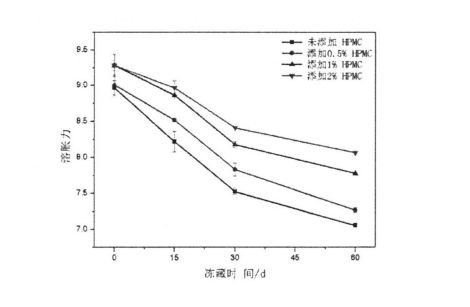
4.3.6.
Krakmolo želatinizacija yra endoterminis cheminis termodinaminis procesas. Todėl DSC dažnai naudojamas nustatyti pradžios temperatūrą (negyvą), smailės temperatūrą (iki), galinę temperatūrą (T P) ir krakmolo želatinizacijos želatinizacijos entalpiją. (Tc). Table 4.4 shows the DSC curves of starch gelatinization with 2% and without HPMC added for different freezing storage times.
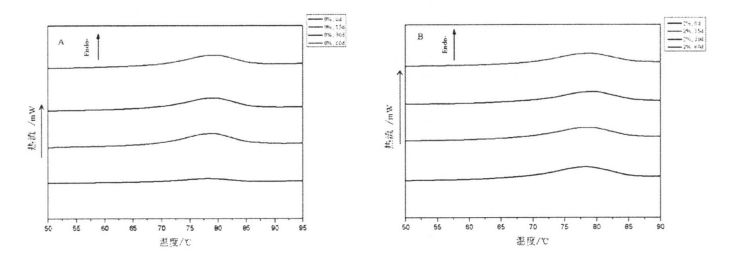
Pastaba: A yra krakmolo DSC kreivė, nepridedant HPMC ir užšaldyta 0, 15, 30 ir 60 dienų: B yra krakmolo DSC kreivė, pridedama 2% HPMC ir užšaldyta 0, 15, 30 ir 60 dienų
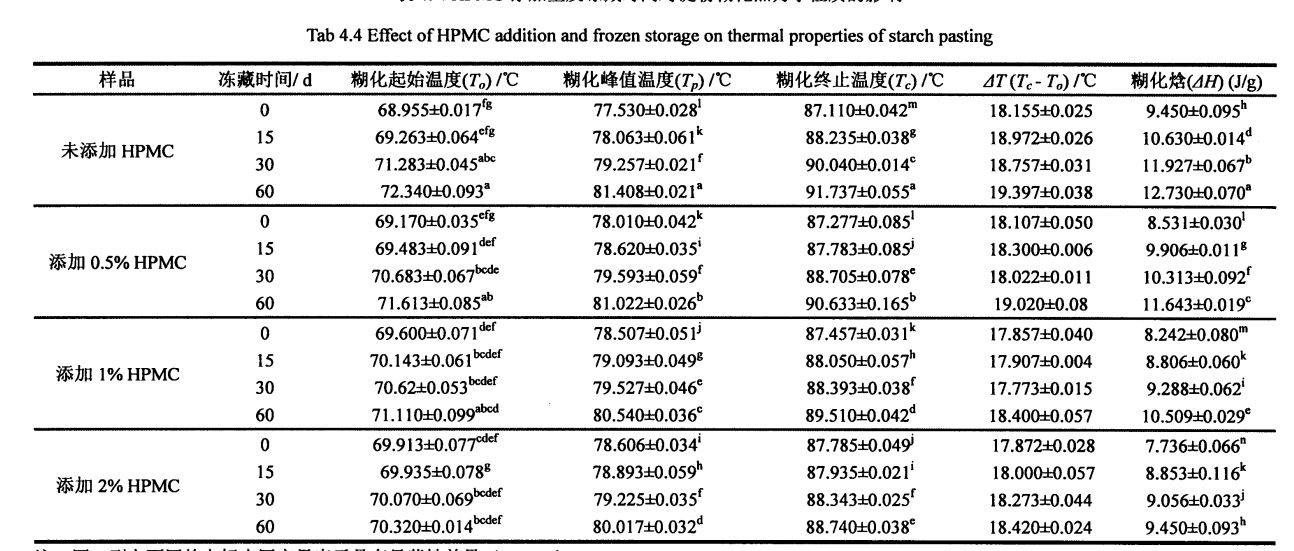
Kaip parodyta 4.4 lentelėje, šviežiam amiloidui, padidėjus HPMC pridėjimui, krakmolo l neturi reikšmingo skirtumo, tačiau žymiai padidėja, nuo 77,530 ± 0,028 (nepridedant HPMC) iki 78,010 ± 0,042 (pridėkite 0,5% HPMC), 78,507 ± 0,051 (pridėkite 1% HPM) ir 78,506060606060, 78,50 ± 0,051 (pridėkite 1% HPM) ir 2% HPMC), tačiau 4H yra reikšmingas sumažėjimas - nuo 9,450 ± 0,095 (nepridedant HPMC) iki 8,53 ± 0,030 (pridedant 0,5% HPMC), 8,242a: 0,080 (pridedant 1% HPMC) ir 7,736 ± 0,066 (pridėkite 2% HPMC). This is similar to Zhou, et a1. (2008) found that adding a hydrophilic colloid decreased the starch gelatinization enthalpy and increased the starch gelatinization peak temperature [172]. This is mainly because HPMC has better hydrophilicity and is easier to combine with water than starch. At the same time, due to the large temperature range of the thermally accelerated gelation process of HPMC, the addition of HPMC increases the peak gelatinization temperature of starch, while the gelatinization Enthalpy decreases.
Kita vertus, krakmolo želatinizacija iki T P, TC, △ T ir △ Hall padidėjo prailginus užšalimo laiką. Tiksliau, krakmolo želatinizacija, pridedant 1% arba 2% HPMC, po užšaldymo 60 dienų neturėjo reikšmingo skirtumo, o krakmolas be 0,5% HPMC buvo pridėtas nuo 68,955 ± 0,01 7 (šaldyta laikymas 0 dienų) padidėjo iki 72,340 ± 0,093 (įšaldyta saugykla 60 dienų), o nuo 69.170 ± 0,035). 71,613 ± 0,085 (užšaldyta saugykla 0 dienų) 60 dienų); Po 60 dienų užšaldyto laikymo krakmolo želatinizacijos augimo greitis sumažėjo padidėjus HPMC pridėjimui, pavyzdžiui, krakmolas, be HPMC pridėtas nuo 77,530 ± 0,028 (užšalusi laikymas 0 dienų) iki 81,028. 408 ± 0,021 (užšalusi saugykla 60 dienų), o krakmolas pridėjo 2% HPMC padidėjo nuo 78,606 ± 0,034 (užšalusi laikymas 0 dienų) iki 80,017 ± 0,032 (užšalusi saugykla 60 dienų). days); Be to, ΔH taip pat parodė tą pačią pokyčio taisyklę, kuri padidėjo nuo 9,450 ± 0,095 (be papildymo, 0 dienų) iki 12,730 ± 0,070 (papildymas, 60 dienų), atitinkamai nuo 8,450 ± 0,095 (be papildymo, 0 dienų) iki 12,730 ± 0,070 (be 60 dienų). 531 ± 0.030 (add 0.5%, 0 days) to 11.643 ± 0.019 (add 0.5%, 60 days), from 8.242 ± 0.080 (add 1%, 0 days) to 10.509 ± 0.029 (add 1%, 60 days), and from 7.736 ± O. 066 (2% addition, 0 days) rose to 9.450 ± 0.093 (2% addition, 60 days). Pagrindinės aukščiau paminėti krakmolo želatinizacijos termodinaminių savybių pokyčiai užšaldyto laikymo proceso metu yra pažeisto krakmolo, kuris sunaikina amorfinį regioną (amorfinį regioną), susidarymas ir padidina kristalinio regiono kristališkumą. Dviejų egzistavimas padidina santykinį krakmolo kristališkumą, o tai savo ruožtu padidina termodinaminių indeksų, tokių kaip krakmolo želatinizacijos smailės temperatūra ir želatinizacijos entalpija, padidėjimą. Tačiau palyginus galima nustatyti, kad per tą patį užšalimo laikymo laiką, padidėjus HPMC, krakmolo želatinizacijos padidėjimas iki T P, TC, ΔT ir ΔH palaipsniui mažėja. Galima pastebėti, kad pridedant HPMC, gali efektyviai išlaikyti santykinį krakmolo kristalų struktūros stabilumą, taip slopindamas krakmolo želatinizacijos termodinaminių savybių padidėjimą.
X. rentgeno spindulių difrakcija (XRD) gaunama X. rentgeno spindulių difrakcija yra tyrimo metodas, analizuojantis difrakcijos spektrą, siekiant gauti tokią informaciją kaip medžiagos sudėtis, atomų ar molekulių struktūra ar morfologija medžiagoje. Because starch granules have a typical crystalline structure, XRD is often used to analyze and determine the crystallographic form and relative crystallinity of starch crystals.
However, with the prolongation of freezing storage time, the relative crystallinity of starch increased from 20.40 + 0.14 (without HPMC, 0 days) to 36.50 ± 0.42 (without HPMC, frozen storage, respectively). 60 days), and increased from 25.75 + 0.21 (2% HPMC added, 0 days) to 32.70 ± 0.14 (2% HPMC added, 60 days) (Figure 4.6.B), this and Tao, et a1. (2016), the change rules of the measurement results are consistent [173-174]. Santykinio kristališkumo padidėjimą daugiausia lemia amorfinės srities sunaikinimas ir kristalinio regiono kristališkumo padidėjimas. Be to, atsižvelgiant į krakmolo želatinizacijos termodinaminių savybių pokyčius, pridėjus HPMC, sumažėjo santykinio kristališkumo laipsnio padidėjimas, o tai parodė, kad užšalimo proceso metu HPMC gali efektyviai slopinti krakmolo kristalų struktūrinį pažeidimą ir išlaikyti jo struktūrą bei savybes ir yra santykinai statūs.
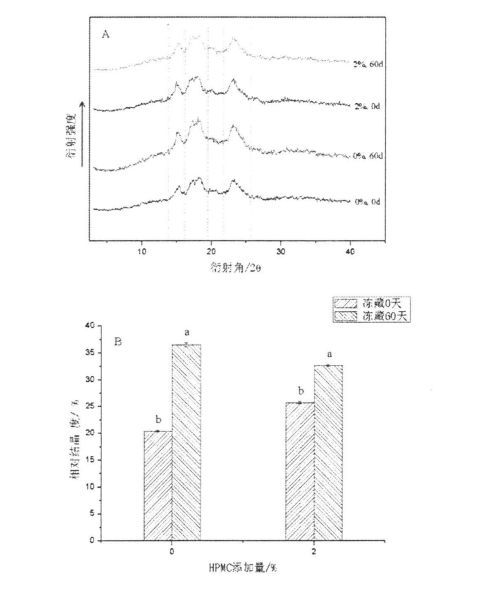
Yeast is a unicellular eukaryotic microorganism, its cell structure includes cell wall, cell membrane, mitochondria, etc., and its nutritional type is a facultative anaerobic microorganism. Anaerobinėmis sąlygomis jis gamina alkoholį ir energiją, o aerobinėmis sąlygomis jis metabolizuojasi gaminti anglies dioksidą, vandenį ir energiją.
Mielėse yra platų fermentuotų miltų produktų naudojimo asortimentą (rūgštynių rūgščiai gaunami natūralios fermentacijos metu, daugiausia pieno rūgšties bakterijos), jos gali naudoti hidrolizuotą krakmolo produktą tešloje - gliukozės ar maltozės kaip anglies šaltinį, aerobinėmis sąlygomis, naudodamas medžiagas, gamindamas anglies dioksidą ir vandenį po kvėpavimo. The carbon dioxide produced can make the dough loose, porous and bulky. At the same time, the fermentation of yeast and its role as an edible strain can not only improve the nutritional value of the product, but also significantly improve the flavor characteristics of the product. Therefore, the survival rate and fermentation activity of yeast have an important impact on the quality of the final product (specific volume, texture, and flavor, etc.) [175].
In the case of frozen storage, yeast will be affected by environmental stress and affect its viability. Kai užšalimo greitis yra per didelis, vanduo sistemoje greitai išsikristalizuos ir padidins mielių išorinį osmosinį slėgį, todėl ląstelės praranda vandenį; Kai užšalimo greitis yra per didelis. If it is too low, the ice crystals will be too large and the yeast will be squeezed and the cell wall will be damaged; Abu sumažins mielių išgyvenamumą ir jo fermentacijos aktyvumą. Be to, daugelyje tyrimų nustatyta, kad po mielių ląstelės plyšo dėl užšalimo, jos išlaisvins redukuojančią medžiagą, kurią sumažina glutationas, o tai savo ruožtu sumažina disulfido ryšį su sulfhidrilo grupe, kuri ilgainiui sunaikins glitimo baltymų tinklo struktūrą, todėl sumažėja makaronų produktų kokybė [176-177].
Angelas Aktyvios sausos mielės
BPS. 500CL constant temperature and humidity box
3M kieto filmo kolonijos greitojo skaičiavimo bandymo kūrinys
Sp. Model 754 UV Spectrophotometer
Ypač švarus sterilus operacinis stalas
KDC. 160 val
ZWY-240 Pastovi temperatūros inkubatorius
Gamintojas
„Shanghai Spectrum Scientific Instrument Co., Ltd.“
Anhui Zhongke Zhongjia Scientific Instrument Co., Ltd.
5.2.2 Eksperimentinis metodas
Weigh 3 g of active dry yeast, add it to a sterilized 50 mL centrifuge tube under aseptic conditions, and then add 27 mL of 9% (w/V) sterile saline to it, shake it up, and prepare 10% (w/w) yeast broth. Tada greitai pereikite prie. Store in a refrigerator at 18°C. After 15 d, 30 d, and 60 d of frozen storage, the samples were taken out for testing. Add 0.5%, 1%, 2% HPMC (w/w) to replace the corresponding percentage of active dry yeast mass. Visų pirma, po HPMC sveriant, jis turi būti apšvitintas po ultravioletine lempute 30 minučių sterilizavimui ir dezinfekavimui.
Žr. Meziani, et A1. (2012) eksperimentinis metodas [17 cituojamas su nedideliais modifikacijomis. Weigh 5 g of frozen dough into a 50 mL colorimetric tube, press the dough to a uniform height of 1.5 cm at the bottom of the tube, then place it upright in a constant temperature and humidity box, and incubate for 1 h at 30 °C and 85% RH, after taking it out, measure the proofing height of the dough with a millimeter ruler (retain two digits after the decimal point). For samples with uneven upper ends after proofing, select 3 or 4 points at equal intervals to measure their corresponding heights (for example, each 900), and the measured height values were averaged. Kiekvienas mėginys buvo lygiagretus tris kartus.
Sverkite 1 g tešlos, įpilkite ją į bandomąjį vamzdelį su 9 ml steriliojo normalaus druskos tirpalo pagal aseptinės operacijos reikalavimus, visiškai suplakite, užfiksuokite koncentracijos gradientą kaip 101, o tada praskieskite į koncentracijos gradientų seriją iki 10'1. Draw 1 mL of dilution from each of the above tubes, add it to the center of the 3M yeast rapid count test piece (with strain selectivity), and place the above test piece in a 25°C incubator according to the operating requirements and culture conditions specified by 3M. 5 d, išimkite po kultūros pabaigos, pirmiausia stebėkite kolonijos morfologiją, kad nustatytumėte, ar ji atitinka mielių kolonijų ypatybes, o paskui skaičiuoja ir mikroskopiškai ištirti [179]. Each sample was repeated three times.
5.2.2.4 Glutationo kiekio nustatymas
The alloxan method was used to determine the glutathione content. The principle is that the reaction product of glutathione and alloxan has an absorption peak at 305 nl. Konkretus nustatymo metodas: 5 ml mielių tirpalo pipetė į 10 ml centrifugos vamzdelį, tada centrifuga esant 3000 aps./min. Na, leiskite stovėti 6 minutes ir nedelsdami įpilkite 1 m, NaOH tirpalas buvo 1 ml, o absorbcija esant 305 nm buvo išmatuota UV spektrofotometru po kruopštaus maišymo. The glutathione content was calculated from the standard curve. Each sample was paralleled three times.
Eksperimentiniai rezultatai pateikiami kaip 4 standartinis vidurkio nuokrypis, o kiekvienas eksperimentas buvo pakartotas bent tris kartus. Analysis of variance was performed using SPSS, and the significance level was 0.05. Use Origin to draw graphs.
5.3 Rezultatai ir diskusija
Tešlos atspindinčiam aukštį dažnai daro įtaką bendras mielių fermentacijos dujų gamybos aktyvumo ir tešlos tinklo struktūros stiprumas. Among them, yeast fermentation activity will directly affect its ability to ferment and produce gas, and the amount of yeast gas production determines the quality of fermented flour products, including specific volume and texture. The fermentation activity of yeast is mainly affected by external factors (such as changes in nutrients such as carbon and nitrogen sources, temperature, pH, etc.) and internal factors (growth cycle, activity of metabolic enzyme systems, etc.).

As shown in Figure 5.1, when frozen for 0 days, with the increase in the amount of HPMC added, the proofing height of the dough increased from 4.234-0.11 cm to 4.274 cm without adding HPMC. -0,12 cm (pridėta 0,5% HPMC), 4,314–0,19 cm (pridėta 1% HPMC) ir 4,594–0,17 cm (pridedama 2% HPMC), tai daugiausia gali būti dėl HPMC papildymo pokyčiai Plektinių tinklo struktūros savybės (žr. 2 skyrių). Tačiau po 60 dienų užšalęs tešlos įrodymas sumažėjo iki skirtingo laipsnio. Tiksliau, tešlos, be HPMC, įrodymo aukštis buvo sumažintas nuo 4,234–0,11 cm (užšalimas 0 dienų) iki 3,18+0,15 cm (užšalusi laikymas 60 dienų); Tešla, pridėta su 0,5% HPMC, buvo sumažinta nuo 4,27+0,12 cm (užšalusi laikymas 0 dienų) iki 3,424–0,22 cm (užšalusi laikymas 0 dienų). 60 dienų); Į 1% HPMC pridėta tešla sumažėjo nuo 4,314–0,19 cm (šaldyta laikymas 0 dienų) iki 3,774–0,12 cm (60 dienų šaldytas laikymas); o tešla, pridėta su 2% HPMC, pabudo. Plaukų aukštis buvo sumažintas nuo 4,594–0,17 cm (užšaldytos laikymo 0 dienas) iki 4,09-± 0,16 cm (60 dienų užšalusi laikymas). Galima pastebėti, kad padidėjus HPMC papildomam kiekiui, pamažu mažėja tešlos įrodinėjimo aukščio sumažėjimo laipsnis. This shows that under the condition of frozen storage, HPMC can not only maintain the relative stability of the dough network structure, but also better protect the survival rate of yeast and its fermentation gas production activity, thereby reducing the quality deterioration of fermented noodles.
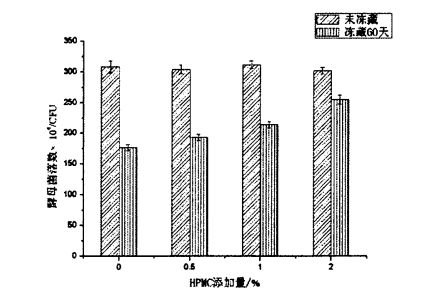
It can be seen from Figure 5.2 that there is no significant difference in the number of yeast colonies in samples with different contents of HPMC added without freezing treatment. This is similar to the result determined by Heitmann, Zannini, & Arendt (2015) [180]. However, after 60 days of freezing, the number of yeast colonies decreased significantly, from 3.08x106 CFU to 1.76x106 CFU (without adding HPMC); from 3.04x106 CFU to 193x106 CFU (adding 0.5% HPMC); reduced from 3.12x106 CFU to 2.14x106 CFU (added 1% HPMC); reduced from 3.02x106 CFU to 2.55x106 CFU (added 2% HPMC). By comparison, it can be found that the freezing storage environment stress led to the decrease of the yeast colony number, but with the increase of HPMC addition, the degree of the decrease of the colony number decreased in turn. Tai rodo, kad HPMC gali geriau apsaugoti mieles šaldymo sąlygomis. The mechanism of protection may be the same as that of glycerol, a commonly used strain antifreeze, mainly by inhibiting the formation and growth of ice crystals and reducing the stress of low temperature environment to yeast. Figure 5.3 is the photomicrograph taken from the 3M yeast rapid counting test piece after preparation and microscopic examination, which is in line with the external morphology of yeast.
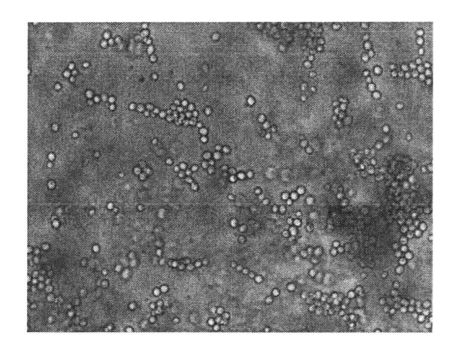
5.3 pav. Mielių mikrografas
5.3.3.
Glutationas yra tripeptido junginys, sudarytas iš glutamo rūgšties, cisteino ir glicino, ir turi dvi rūšis: sumažintas ir oksiduotas. When the yeast cell structure is destroyed and died, the permeability of the cells increases, and the intracellular glutathione is released to the outside of the cell, and it is reductive. It is particularly worth noting that reduced glutathione will reduce the disulfide bonds (-SS-) formed by the cross-linking of gluten proteins, breaking them to form free sulfhydryl groups (.SH), which in turn affects the dough network structure. Stabilumas ir vientisumas ir galiausiai pablogina fermentuotų miltų gaminių kokybę. Usually, under environmental stress (such as low temperature, high temperature, high osmotic pressure, etc.), yeast will reduce its own metabolic activity and increase its stress resistance, or produce spores at the same time. When the environmental conditions are suitable for its growth and reproduction again, then restore the metabolism and proliferation vitality. However, some yeasts with poor stress resistance or strong metabolic activity will still die if they are kept in a frozen storage environment for a long time.
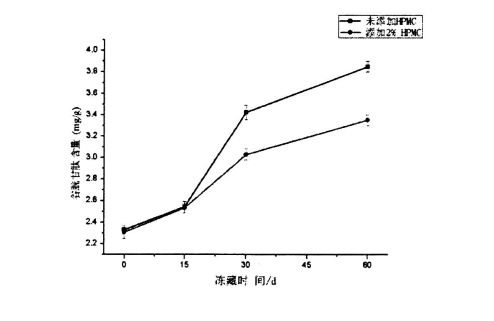
As shown in Figure 5.4, the glutathione content increased regardless of whether HPMC was added or not, and there was no significant difference between the different addition amounts. This may be because some of the active dry yeast used to make the dough have poor stress resistance and tolerance. Esant žemos temperatūros užšaldymui, ląstelės miršta, o po to išsiskiria glutationas, kuris yra susijęs tik su pačių mielių charakteristikomis. Tai susiję su išorine aplinka, tačiau neturi nieko bendra su pridėtu HPMC kiekiu. Todėl glutationo kiekis padidėjo per 15 dienų nuo užšalimo ir reikšmingo skirtumo tarp jų nebuvo. However, with the further extension of the freezing time, the increase of glutathione content decreased with the increase of HPMC addition, and the glutathione content of the bacterial solution without HPMC was increased from 2.329a: 0.040mg/ g (frozen storage for 0 days) increased to 3.8514-0.051 mg/g (frozen storage for 60 days); Nors mielių skystis pridėjo 2% HPMC, jo glutationo kiekis padidėjo nuo 2,307+0,058 mg/g (užšalusi saugykla 0 dienų) padidėjo iki 3,351+0,051 mg/g (šaldyta saugykla 60 dienų). Tai taip pat parodė, kad HPMC galėtų geriau apsaugoti mielių ląsteles ir sumažinti mielių mirtį, taip sumažinant glutationo, išsiskiriančio į ląstelės išorę, kiekį. Taip yra daugiausia todėl, kad HPMC gali sumažinti ledo kristalų skaičių, taip efektyviai sumažindamas ledo kristalų stresą iki mielių ir slopindamas tarpląstelinio glutationo išsiskyrimo padidėjimą.
5.4 Skyriaus santrauka
Yeast is an indispensable and important component in fermented flour products, and its fermentation activity will directly affect the quality of the final product. In this experiment, the protective effect of HPMC on yeast in frozen dough system was evaluated by studying the effect of different HPMC additions on yeast fermentation activity, yeast survival number, and extracellular glutathione content in frozen dough. Through experiments, it was found that the addition of HPMC can better maintain the fermentation activity of the yeast, and reduce the degree of decline in the proofing height of the dough after 60 days of freezing, thus providing a guarantee for the specific volume of the final product; in addition, the addition of HPMC effectively The decrease of yeast survival number was inhibited and the increase rate of reduced glutathione content was reduced, thereby alleviating the damage of glutathione to dough network structure. Tai rodo, kad HPMC gali apsaugoti mieles, slopindamas ledo kristalų susidarymą ir augimą.
Pašto laikas: 2012 m. Spalio-08 d







